Cultivating Carnivorous Plants (2015)
UTRICULARIA
Traps of Utricularia aurea.41
179
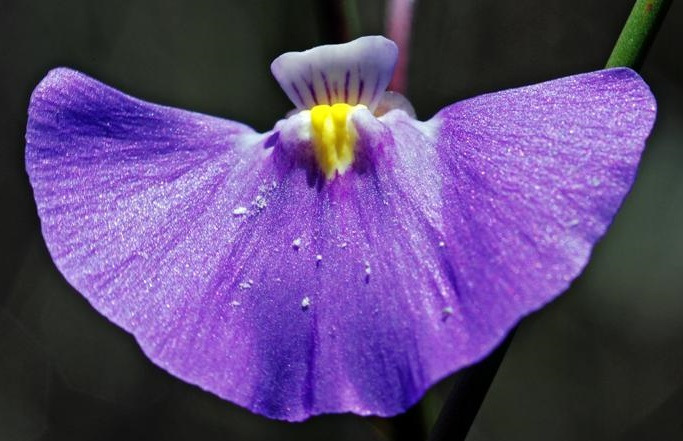












CULTIVATING CARNIVOROUS PLANTS
Utricularia quelchii flowers alongside Drosera roraimae on Mt. Roraimae.42
The most widespread and underappreciated carnivorous plant is the Bladderwort. Its traps are small,
only a millimeter or so in size for most species and growing up to a centimeter in length for the largest
species ( U. arnhemica, U. humboldtii, and U. reflexa). The plants themselves are often hard to spot when not in
flower. Aquatic species, of which there are about 50, often look like a tangle of thin strands of vegetation in
somewhat murky waters. Terrestrial species often only have a few tiny grass-like “leaves,” which are easily
buried by other vegetation. Only epiphytic species have “leaves” of any size, and most of these species grow
in fairly difficult-to-access tropical areas.
Much work has been done on dividing the 233 species of Utricularia into three subgenera ( Bivalvaria,
Polypompholyx, and Utricularia). This work revealed that the genus Utricularia is so diverse that not even the traps unite this genus. In most Bladderworts, the traps are, more or less, hollow bladders. These traps,
regardless of whether they are found on aquatic, terrestrial, or epiphytic species all function in much the same
way. The hollow bladder trap is largely empty of fluid in its ready state. When the trap is triggered, a small
“door” opens, creating a vacuum which sucks the prey animal inside
the trap within five milliseconds. Most Utricularia prey consists of
zooplankton, but large-trapped Utricularia species have been known
to capture prey as large as mosquito larvae.
Interestingly, scientific research on how this type of trap is
triggered is still ongoing hundreds of years after it was determined
that the traps are carnivorous. The conventional explanation is that,
much like a Venus Flytrap or Waterwheel plant, the prey animal
triggers the bladder trap via manual stimulation of one of the trigger
hairs outside the trap. New research has revealed that there are a
Utricularia volubilis43
180








NATCH GREYES
variety of different sensors outside the
traps, which can cause the traps to fire
in the absence of manual stimulation.
Within
the
Polypompholyx
subgenus, there are two species,
Utricularia multifida and Utricularia tenella,
which have markedly different traps.
These two species actually have traps
that are similarly bladder-shaped but
do not have the vacuum mechanism of
the rest of the species. Instead, they
are, in a sense, more “primitive,”
similar to the Genlisea. These “channel
traps,” actually have a small bit of low
pressure inside them, enticing prey
animals to enter and travel towards the
back of the trap.
Although much could be said
Utricularia reniformis ‘Enfant Terrible’
about the division of Utricularia into
subgenera, sections, and species, as a practical matter, there are three main “types” of Bladderwort -- aquatic,
terrestrial, and epiphytic. The major difference is with aquatic and non-aquatic species. Aquatics, such as
Utricularia gibba or Utricularia australis, are best cultivated in aquariums, ponds, or other aquatic environments.
Non-aquatic species, such as Utricularia dichotoma, are best grown in a pot, bog, or other non-water-based
media. This chapter will be subdivided based on these three main “types” rather than technical scientific
divisions.
Aquatic Utricularia
Aquatic Utricularia consist of approximately 50
different species of Utricularia. Most flower in the
early spring and grow stalks upon which two to four
flowers appear several inches above the water. Most
species have yellow flowers, but some, such as
Utricularia purpurea, have other colors (purple in the
case of Utricularia purpurea).
Aquatic Utricularia grow in one of two ways,
either along a central “stem,” like a Waterwheel
Plant, or as part of a clustered mass of stringy
threads. Central stem growing Utricularia, such as
Utricularia
australis,
Utricularia
macrorhiza,
or
Utricularia inflata, are more common and generally
present as having a single, thick “stem” from which
a whorl of branches and traps radiate. In contrast,
thread-like Utricularia, such as Utricularia gibba, grow
as one continuous mass of interwoven threads. For
Utricularia gibba flower.44
both these growth patterns, division of plants is
181






CULTIVATING CARNIVOROUS PLANTS
similar - divide off a section, making sure to remove part of the central stem from central stem growing
plants.
Due to the similarity of the flower color and the growth pattern of most aquatic Utricularia, it can be
difficult to tell species of aquatic Utricularia apart. This is also complicated, in the wild, because in many areas
multiple species ranges overlap.
U. australis
One
of
the
most
widespread aquatic Utricularia,
Utricularia australis grows from
Europe to Australia. Although
its range does not extend to
the
Americas,
Utricularia
australis is commonly cultivated
in North America.
As with Aldrovanda, its
growth pattern is for branches
to grow off a central stalk.
Unlike Aldrovanda, Utricularia
australis has large, branching
stalks, instead of a whorl of
traps. The bladder traps grow
off these branches.
Utricularia australis traps.45
U. gibba
Utricularia gibba is one of the most common aquatic Utricularia in cultivation, and in the wild. It grows as
a dense mat of thin, thread-like strings off of which sprout its bladders. As far as aquatic Utricularia go, it is
most definitely the easiest and most forgiving species to grow. Most clones of it in cultivation probably
originate from subtropical locations and can be grown year-round in anything from a coffee cup full of
rainwater to a large, outdoor pond feature.
Once a plant becomes sufficiently sized, seasonal
changes will cause it to flower in early-to-mid summer.
Unlike some aquatic or terrestrial species, flowering does
not seem to be induced by changes in water level, but,
instead, light or temperature cues.
U. graminifolia
Utricularia graminifolia is an interesting species because
it is one of the few which can treated either as an aquatic
or terrestrial species. Often, growers will treat is as an
aquatic Utricularia and grow it completely submerged. It
can, however, be grown as a terrestrial species. As a
consequence of its ability to grow either as an aquatic or
Utricularia graminifolia flower.
terrestrial species, Utricularia graminifolia is one of the
182
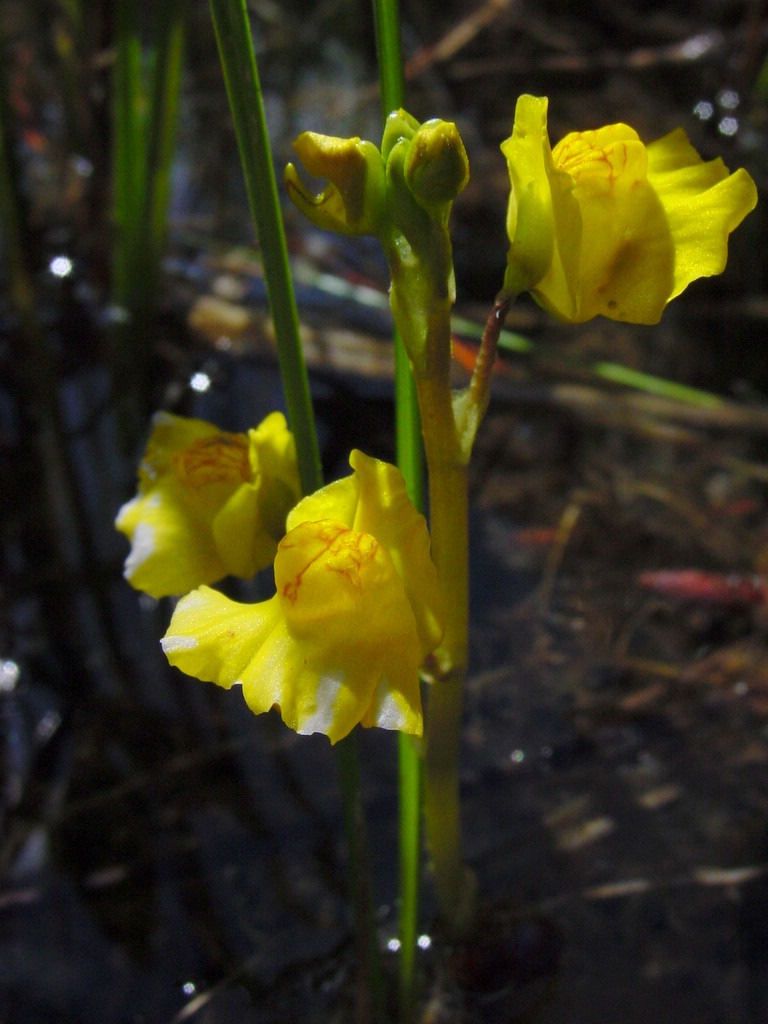
NATCH GREYES
easiest species to cultivate long-term. In fact, it is more tolerant of a wide range of conditions than most
Utricularia, as it can grow either in a terrarium, an aquarium (with fish!), or in a bog garden.
In cultivation, Utricularia graminifolia is particularly popular among those who have fish. It will tolerate
most conditions favorable to fish and forms a lush, green carpet on the bottom of a fish tank. Frequently, it
can be obtained at stores that specialize in fish.
U. inflata
Utricularia inflata is one of the rare, invasive carnivorous plants. Originally native to the southeastern
United States, Utricularia inflata was introduced into a few ponds in Washington state a decade or two ago.
Today, it is classified as an invasive species. Additionally, as the climate has changed, it has managed to
expand its range as far north as Massachusetts in
recent years thanks to migrating birds.
In cultivation, Utricularia inflata prefers to be
grown in water features with at least two feet (one-
half meter) of water. It will, however, tolerate
shallower or deeper water. It is advisable to include
other aquatic plants in the environment for
successful long-term cultivation. Furthermore,
Utricularia inflata should probably not be exposed to
entirely frozen conditions.
U. macrorhiza
One of the most popular aquatic Utricularia in
cultivation, Utricularia macrorhiza has growth pattern
which is very similar to the growth pattern of
Utricularia australis. As with Utricularia australis,
branches holding bladder traps radiate from a
central stem.
In nature, Utricularia macrorhiza grows across a
large portion of the world, making it difficult to
give an exact prescription for growth, as the
necessity and length of dormancy will depend upon
the location of the original specimen. In
cultivation, it is an exceedingly easy plant. Most
forms will grow alongside Utricularia gibba and
Aldrovanda without issue or crowding.
Utricularia macrorhiza flower.46
U. radiata
Another native to the United States, Utricularia radiata is, in many respects, identical to Utricularia inflata,
but has a noticeably smaller whorl of inflated branches keeping the flower stalk afloat. These smaller branches
mean that Utricularia radiata can be grown in a smaller amount of water than Utricularia inflata. (Additionally, it
is also rumored to be less invasive). As with Utricularia inflata, Utricularia radiata has yellow flowers.
My standard growing guide for aquatic Utricularia follows:
183












CULTIVATING CARNIVOROUS PLANTS
✵
Media: Grow aquatic Utricularia in water. The exact conditions necessary will vary, depending on the
species, but, as a general rule, I like to fill an aquarium halfway to three-quarters full with rainwater
after adding a couple inches of wet sphagnum peat. I let the peat settle (and scoop off the floating
bits), and add in some reedy non-carnivorous aquatics, such as Papyrus. I then go to a local pond,
preferably one with Utricularia, but any acidic pond will do, get a cup-full of water and bring that back
to dump in the aquarium, thus introducing some prey animals.
✵
Moisture: Unless growing a species from someplace such as Australia, which requires a drier
dormancy, try to keep at least a few inches of water in the aquarium at all times.
✵
Humidity: Humidity is not really an issue for aquatic Utricularia.
✵
Aquarium Size: My rule of thumb is to get an aquarium big enough that the plant will not be
crowded. For some species, such as Utricularia gibba, the plant will be happy growing in as little as an
inch of standing water. Others, such as Utricularia inflata or Utricularia purpurea need about a foot of
water in order to grow to a size that will maximize flowering.
✵
Feeding: The introduced pond water should provide the aquatic Utricularia with all the prey animals it
needs. Generally, I avoid adding fertilizer to the aquatic Utricularia media as that has a tendency to
encourage algae growth, which can impair Utricularia growth.
✵
Temperature: The necessary temperature for any given Utricularia depends on its native conditions.
Some, such as the temperate Utricularia vulgaris will form winter turions, i.e. hibernation-buds, and go
dormant, while others, such as the subtropical Utricularia inflata will continue to grow year round.
✵
Dormancy: The need for dormancy will depend on the originating location of the plant.
✵
Propagation: The easiest way to propagate an aquatic Utricularia is just to tear off a section of the
plant while it is growing. Since Utricularia lack most ordinary plant features, even the smallest piece
can, theoretically, be used to grow a whole new plant. As the plant enters dormancy, it is possible to
separate turions and divide it that way. Growing from seed is also possible, but most species have
extremely short-lived, miniscule seeds which are difficult to germinate on purpose.
Terrestrial Utricularia
Utricularia reticulata flowers.47
184



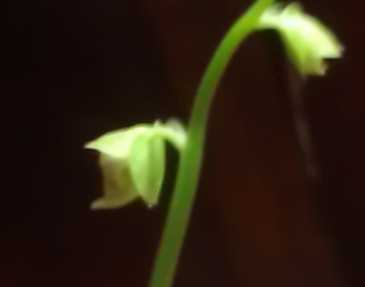
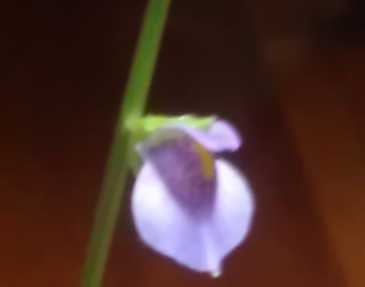

NATCH GREYES
The grand majority of Utricularia fall into the “terrestrial” category. This broad category covers, generally,
all species that grow in annually wet or permanently wet environments with small “leaves” and, often, small,
colorful flowers. Ordinarily, plants of this type have thin, white, filamentous stems off which grow the
bladder-traps and small, green “leaves.” The “leaves” are not true leaves, rather photosynthetic stolons, but,
for the sake of simplicity most growers call them “leaves.” Flowers are usually a quarter inch long or so and
sprout atop relatively tall, thin stems, which grow between four inches and a foot high.
U. blanchetii
Utricularia blanchetii is an annual
which can grow for an extended
period of time in cultivation before
dying. If potted in a sphagnum
peat-heavy mix and given a high
water level, its tiny, needle thin
leaves will carpet its growing
medium in no time. Shortly
thereafter, flower stalks containing
the minute white, yellow, and
purple flowers will emerge from the
carpet.
The flowers are among the
most colorful of the terrestrial
Utricularia in cultivation. The center
of the flower is a blotch of yellow.
Below this falls a (proportionally)
large, white skirt, making the flower
look almost like a dancer. Crowning
Utricularia blanchetti flowers. This species is often confused with
the top of the yellow area is a
U. parthenopipes, which has very similar flowers.
purple tiara, completing the picture.
U. calycifida
Brazil, Guyana, Suriname, and Venezuela, it has large, teardrop-shaped leaves. These
are deeply veined with purple in most specimens. Unlike most other terrestrials, it requires
temperatures between 50° F (10° C) and 86° F (30° Celsius). Too cold and the plant will die
off. Too hot and it will seemingly melt.
To date, there are five Utricularia calycifida cultivars - ‘Asenath Waite,’ ‘Cthulhu,’
‘Lavinia Whateley,’ ‘Mrs. Marsh,’ and ‘Yog-Sothoth’ - all named after H.P. Lovecraft novels.
The most common cultivars in cultivation are ‘Asenath Waite’ and ‘Yog-Sothoth,’ although
the other three are sometimes available.
In good conditions, Utricularia calycifida will grow rapidly, putting off many, many
plantlets from various growth points along its long, white stolons. Each mature growth
point will send up one to three flower stalks. Each flower stalk will hold a half-dozen or so
U. calycifida
flowers. Unlike many other terrestrial Utricularia, Utricularia calycifida prefers to be grown in
‘Asenath Waite’ live sphagnum.
185
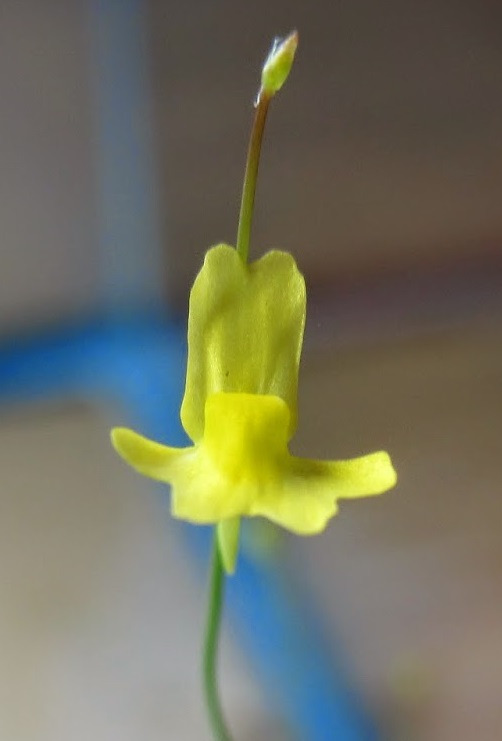
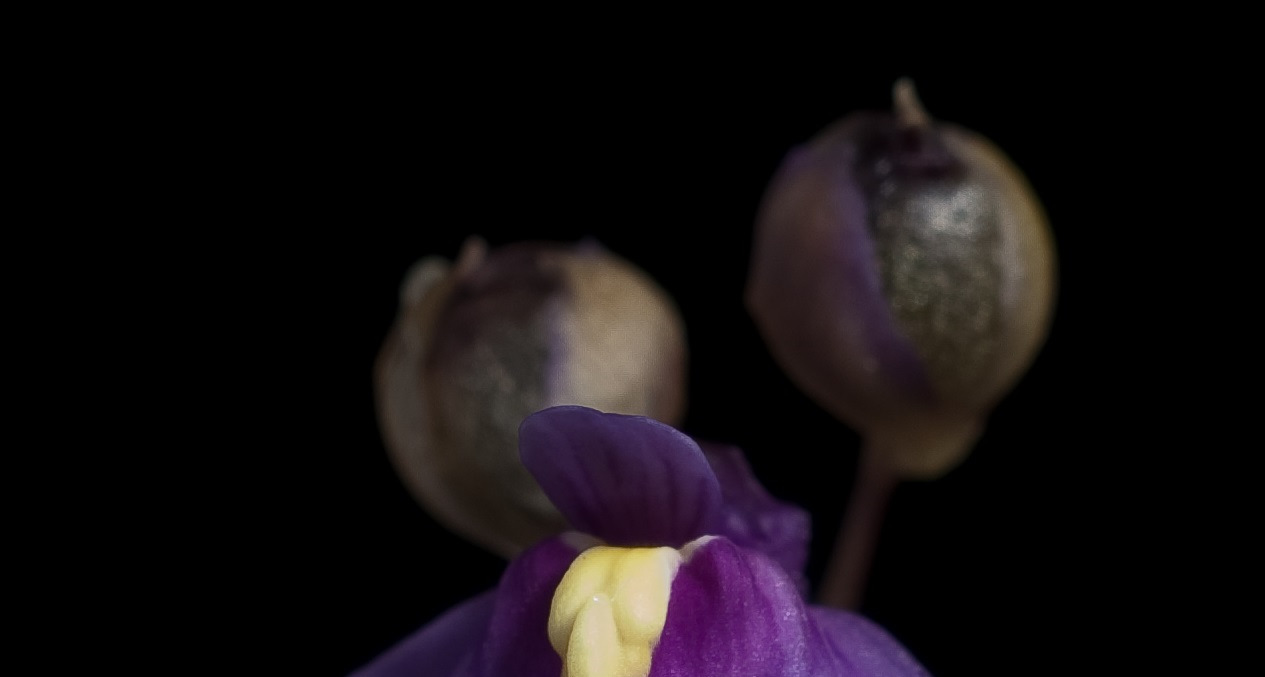
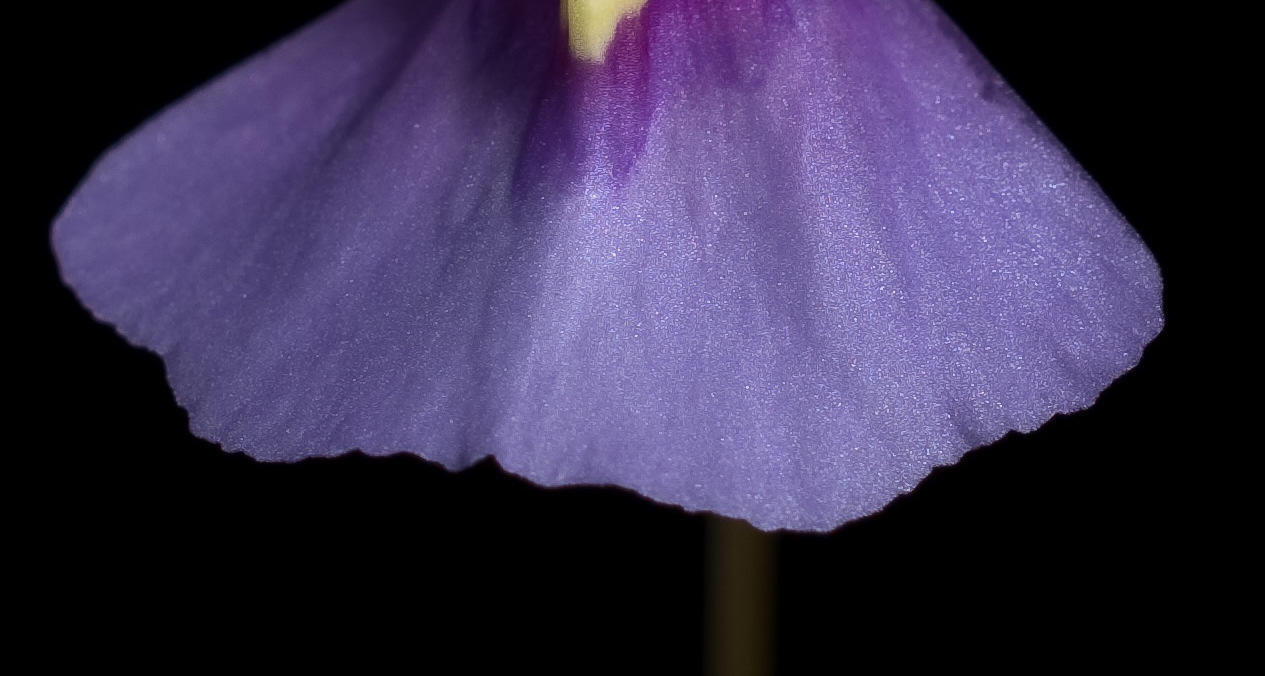
CULTIVATING CARNIVOROUS PLANTS
U. chrysantha
An annual known for its plethora of yellow flowers, Utricularia chrysantha
is a fantastic addition to any bog garden. Its flowers, nearly twice as large as
the ubiquitous Utricularia subulata, are remarkably showy. They look, in some
ways, like an animal’s face, with two long ears extending up from behind the
head.
Among the annual, terrestrial Utricularia, Utricularia chrysantha is one of the
most likely to bloom. Unlike other annual, terrestrial Utricularia, Utricularia
chrysantha is, in cultivation, more likely to exhibit the characteristics of an
annual, i.e. flower prolifically until successful at setting seed many times. As a
consequence, Utricularia chyrsantha will flower in almost any condition.
The seed is small and brown. Around twenty seeds are in each seedpod.
Cold stratification is not necessary for the seed to germinate, if, however,
stratification does occur, freezing solid will not result in the death of the seed,
as many growers in cold climates have learned. If this species is sewn into a
bog garden, expect it to come back year after year.
Utricularia chrysantha
U. dichotoma Complex
The Utricularia dichotoma Complex is a perennial favorite of carnivorous plant collectors. All members of
the Utricularia dichotoma Complex are characterized by their purple or purplish flowers. These consist of a large
(up to an inch (2.5 cm)) long purple or purplish skirt capped by central yellow splotch. The photosynthetic
“leaves” for most species are oval-shaped and thick.
The white underground stolons off of which growth
the photosynthetic “leaves" and bladder traps are
notably thick.
Thanks to Australian carnivorous plant
enthusiasts, especially Allen Lowrie, most, if not all,
species of the Utricularia dichotoma Complex have
now been formally described and detailed maps of
their ranges have been produced. This has greatly
reduced confusion between species in the field. In
cultivation, however, confusion still abounds and
many species of the complex are still described
under the name Utricularia dichotoma. Growers should
be careful to compare their plants labeled Utricularia
dichotoma against Lowrie's Magnum Opus to ensure
that they do not actually have one of the companion
species.
All members of the Utricularia dichotoma
Complex are, to my knowledge, easy terrestrial
Utricularia. They are notably slower growers than
Utricularia dichotoma. This species is often confused
“weedy” species such as Utricularia livida, and prefer
with a number of similar Australian species.48
to grow in a sphagnum-peat heavy mix.
186
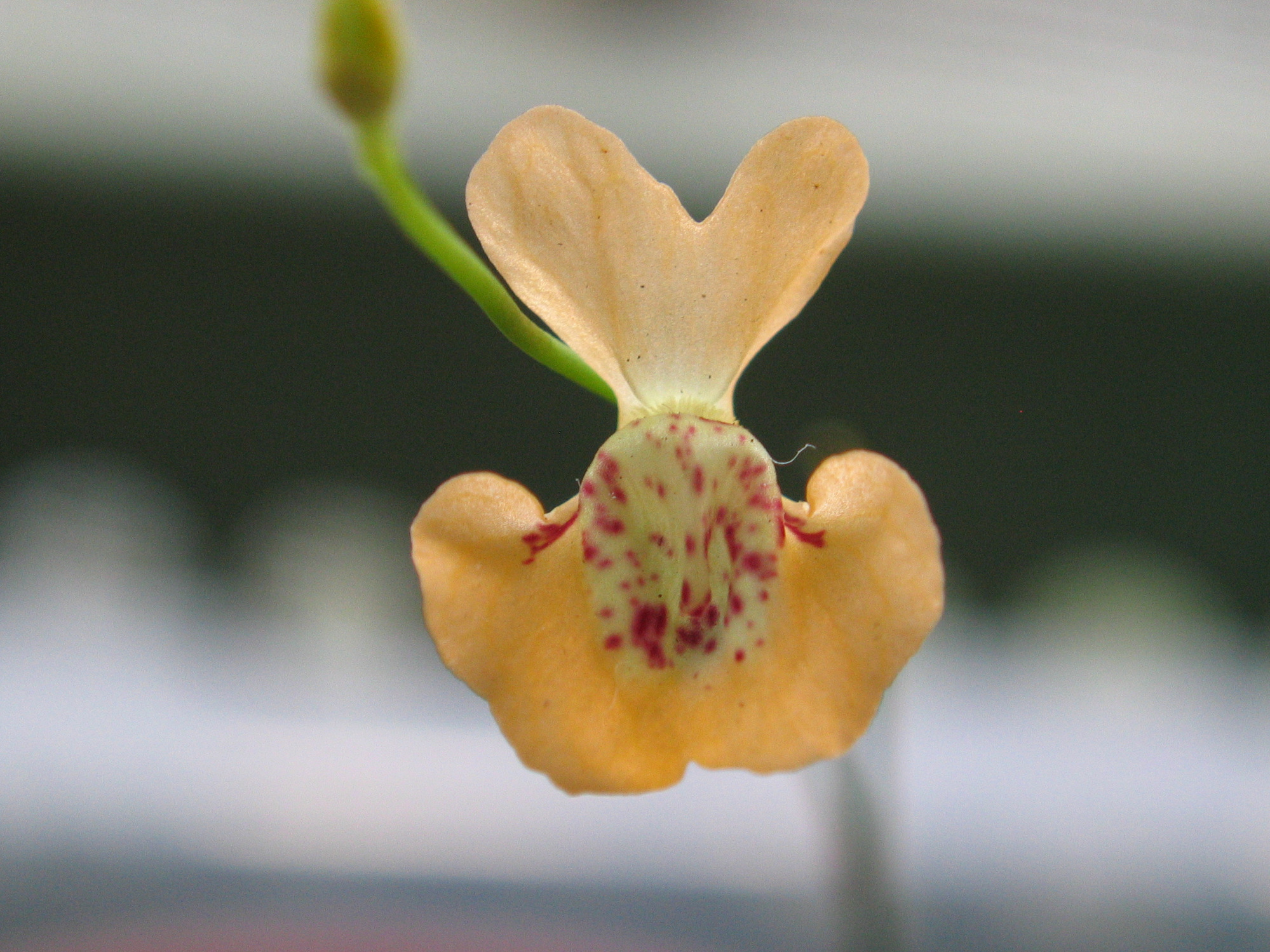
NATCH GREYES
Utricularia fulva49
U. fulva
Utricularia fulva is one of my favorite terrestrial Utricularia. It's easy to see why. The typical plants has
bright orange flowers with their bright orange ears, the whitish bump in the middle of the flower, and red
speckles. Other varieties include yellow, instead of orange, and pink, instead of orange. To my knowledge,
besides the typical form, only the yellow-flowered form has entered cultivation.
In the wild, Utricularia fulva grows in a variety of habitats - in and around sandy or sandstone-base
permanent and wet season creeks; on the margins of billabongs; in herb fields along drainage lines; near
springs, especially those ringed by sandstone; in seasonal swamps and floodplains; and along many sandy, wet
depressions near the Arnhem Land Escarpment in the Northwest Territory of Australia. It appears to be a
common species through its range and can often be found near Utricularia odorata, a yellow-flowered terrestrial
Utricularia, in its homeland. When not in flower, it is difficult to spot Utricularia fulva, as its photosynthetic
“leaves” are tiny, much like Utricularia subulata.
Although still rare in cultivation, Utricularia fulva is an exceedingly easy species to grow. It is, however,
somewhat difficult to induce flowering in this species. In order to induce Utricularia fulva into flowering, it is
advisable to keep the water level high, even an inch or two (3-5 cm) above the level of the media.
Temperatures must remain above 70° F (21° C) to induce flowering. If using artificial light, a long light period
(10 - 12 hours) is beneficial.
187


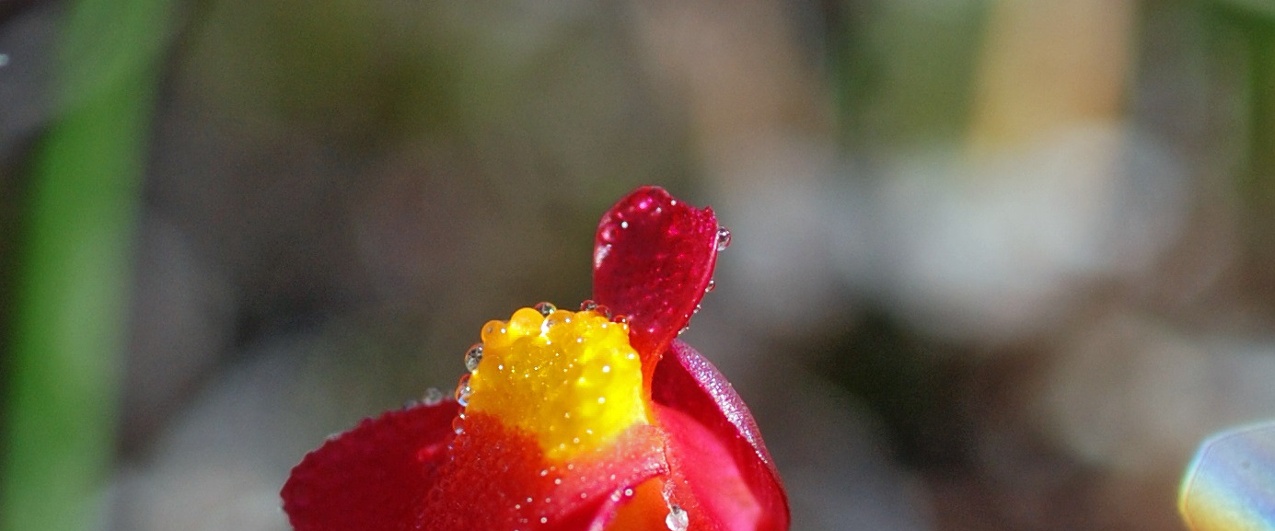
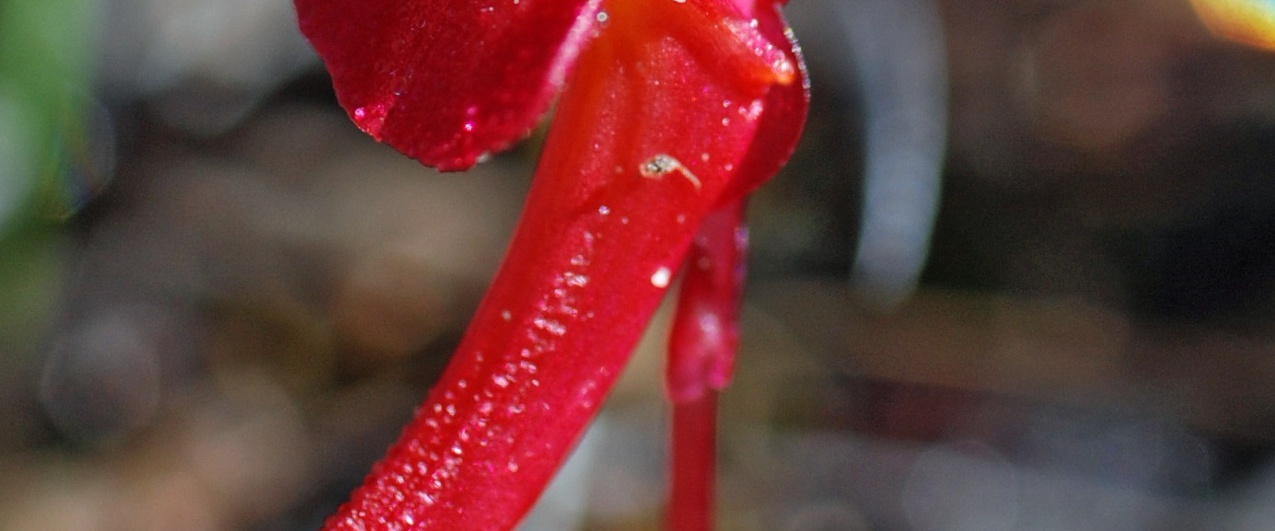
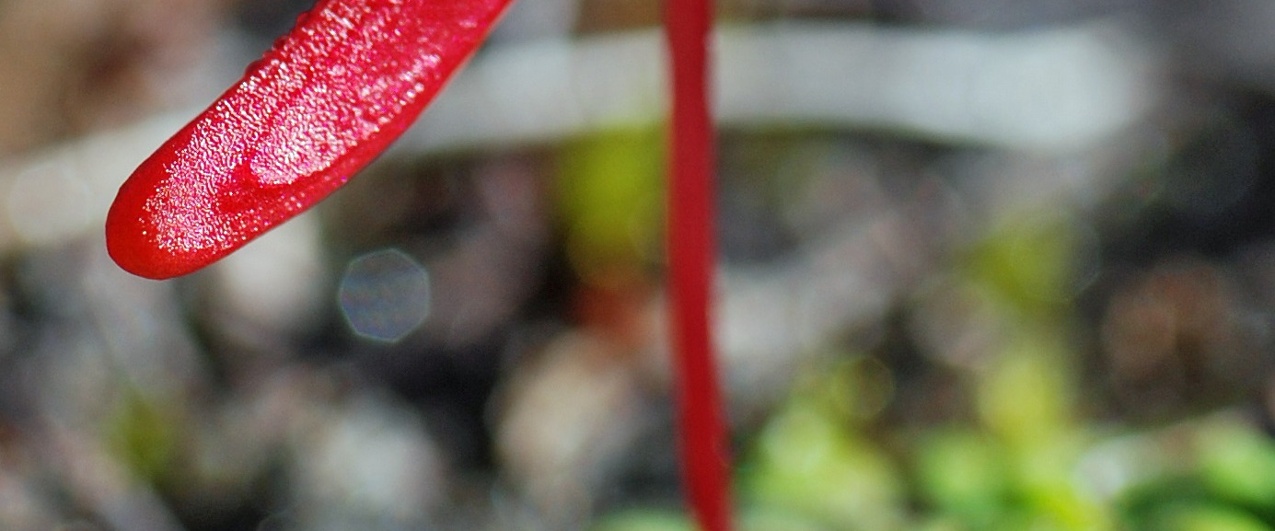
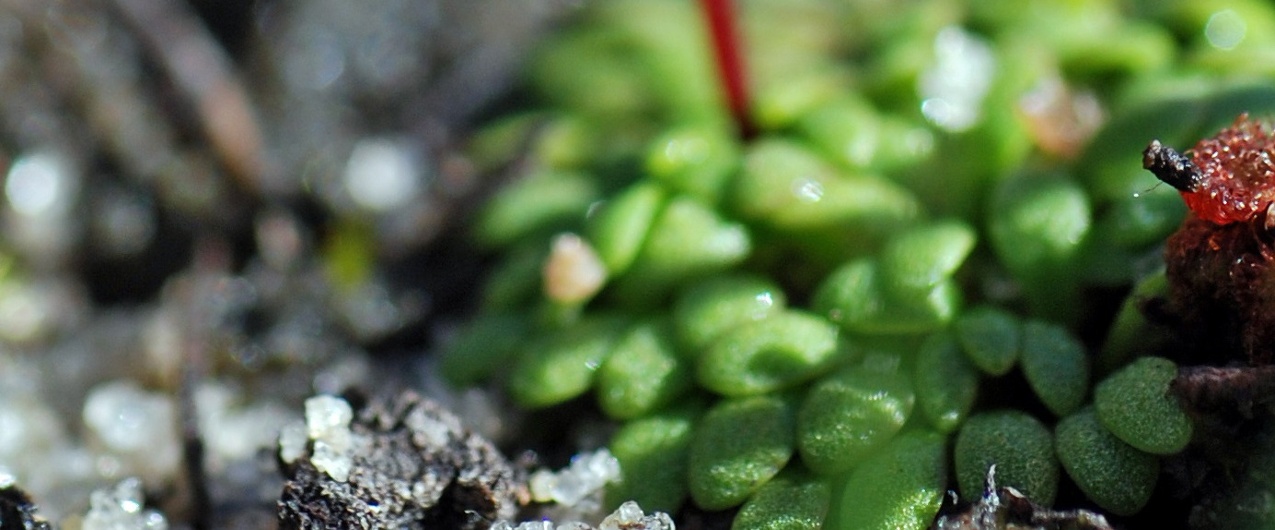
CULTIVATING CARNIVOROUS PLANTS
U. lateriflora
Utricularia lateriflora is a terrestrial species with stunning
purple and white flowers. These rise sparingly from the base of
“leaves” and cluster in sets of one or two per flower stalk, rather
than sets of a half-dozen or so, as is common with other
terrestrial species. In cultivation, it is less apt to flower than
many other terrestrial species, although some measures can be
taken to encourage flowering.
In cultivation, it prefers to be grown in a sphagnum peat-
heavy potting mix. Allowing the water table to almost reach the
surface of the media appears to encourage flowering, although
flowering is sporadic. Changes in amount of light and
temperature do not appear to have any effect upon flowering.
The scarcity of flowers makes this species more highly prized in
collections, and is a centerpiece when it does flower.
Utricularia lateriflora
U. livida
An African native, Utricularia livida has spread to
collections across the world. It is an incredibly prolific
flowerer and spreader, making a weed in many collections.
Yet, despite its prolific nature, only a couple clones have
become common. These clones have a white flower with a
blotch of lavender on their top. Other varieties of
Utricularia livida have pale yellow flowers, purple flowers, all
white flowers, and, even, bluish flowers.
Easy to grow, Utricularia livida with thrive in any slurry
that contains sphagnum. It flowers profusely when given a
lot of light and temperatures reach 65°+ F (18° C). The
“leaves” are virtually identical to those of Utricularia
sandersonii, but the flowers are very different. ( Utricularia
sandersonii, famously, has “bunny” flowers). Therefore, it is
almost impossible to tell the two species apart when not in
flower, although Utricularia livida will spread more rapidly
than Utricularia sandersonii.
U. menziesii
The famous red flowered Bladderwort, Utricularia
menziesii, is known to Australians as “Redcoats” in honor of
its red flowers. It is a small, curious terrestrial Utricularia,
native to the coastal regions of Western Australia, where it
only grows during the cool, wet winters.
Utricularia menziesii, the only known
In summer, Utricularia menziesii retreats to a corm,
tuberous Utricularia species.50
where it awaits the fall rains to reawaken it. Upon the
188
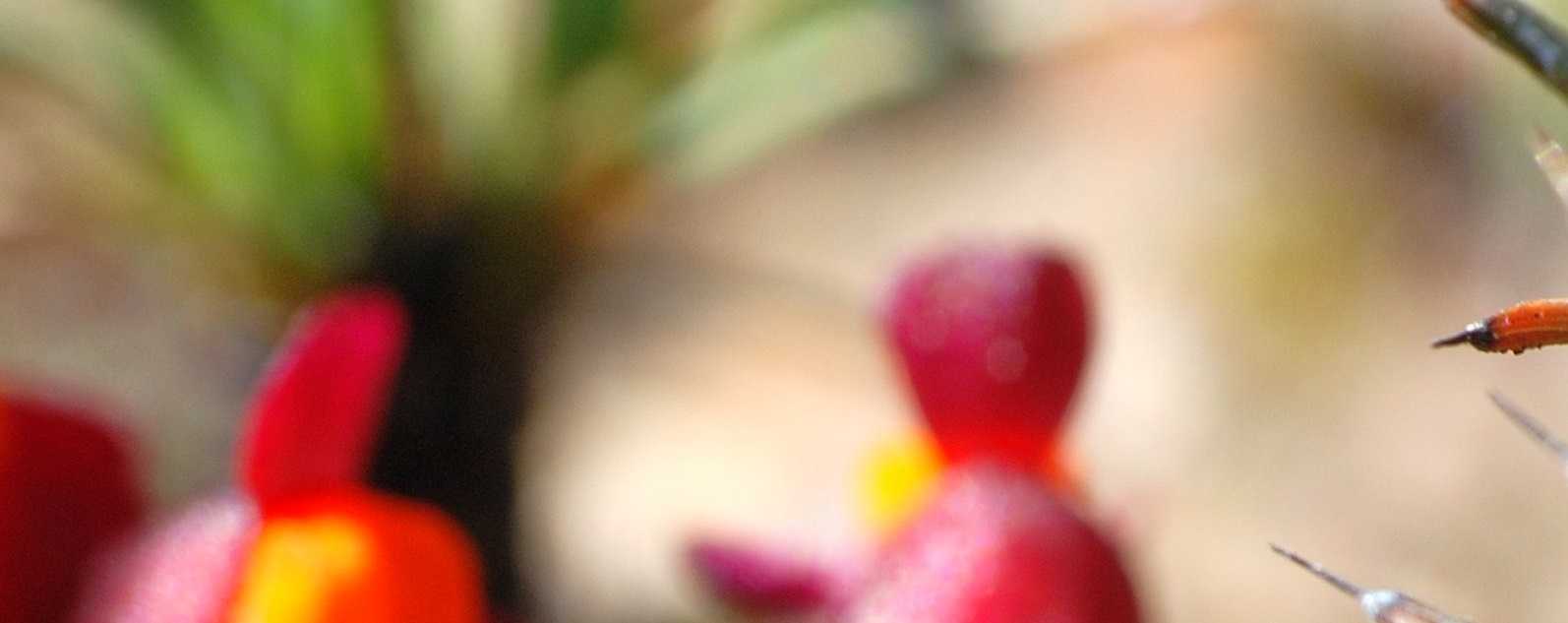
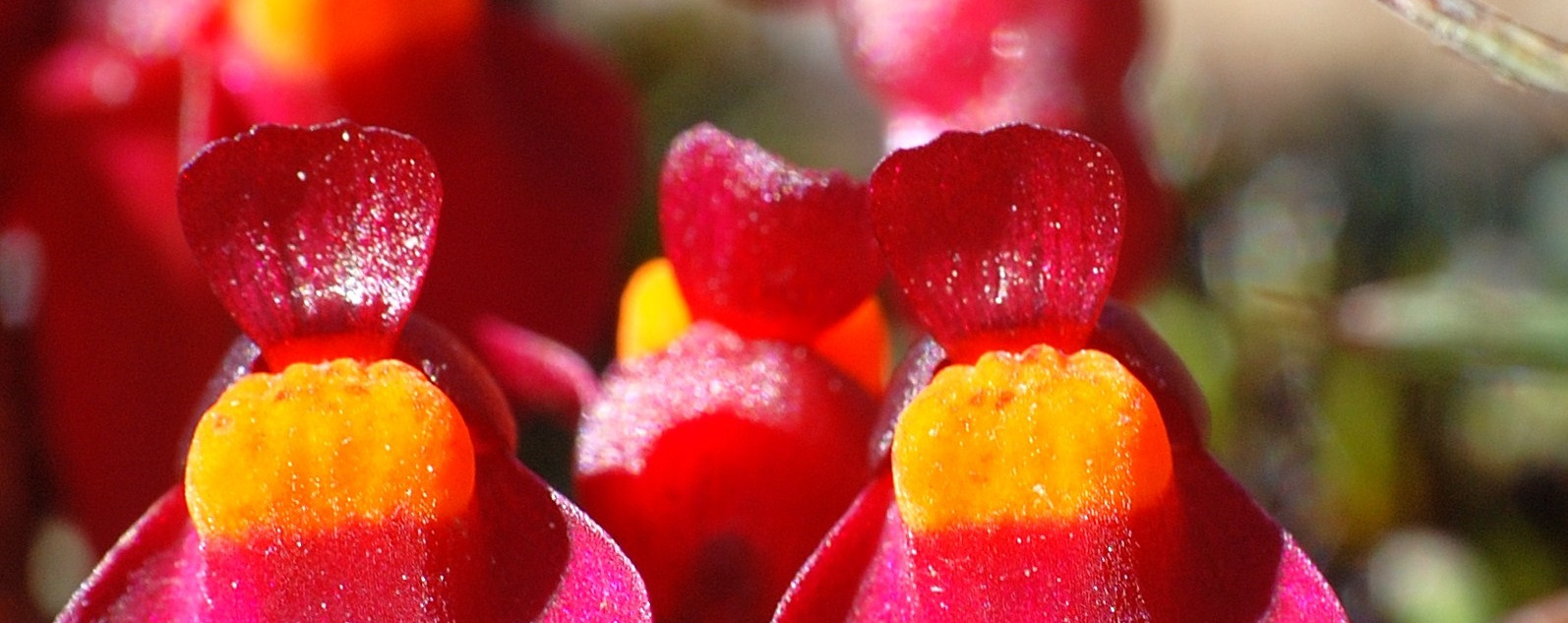
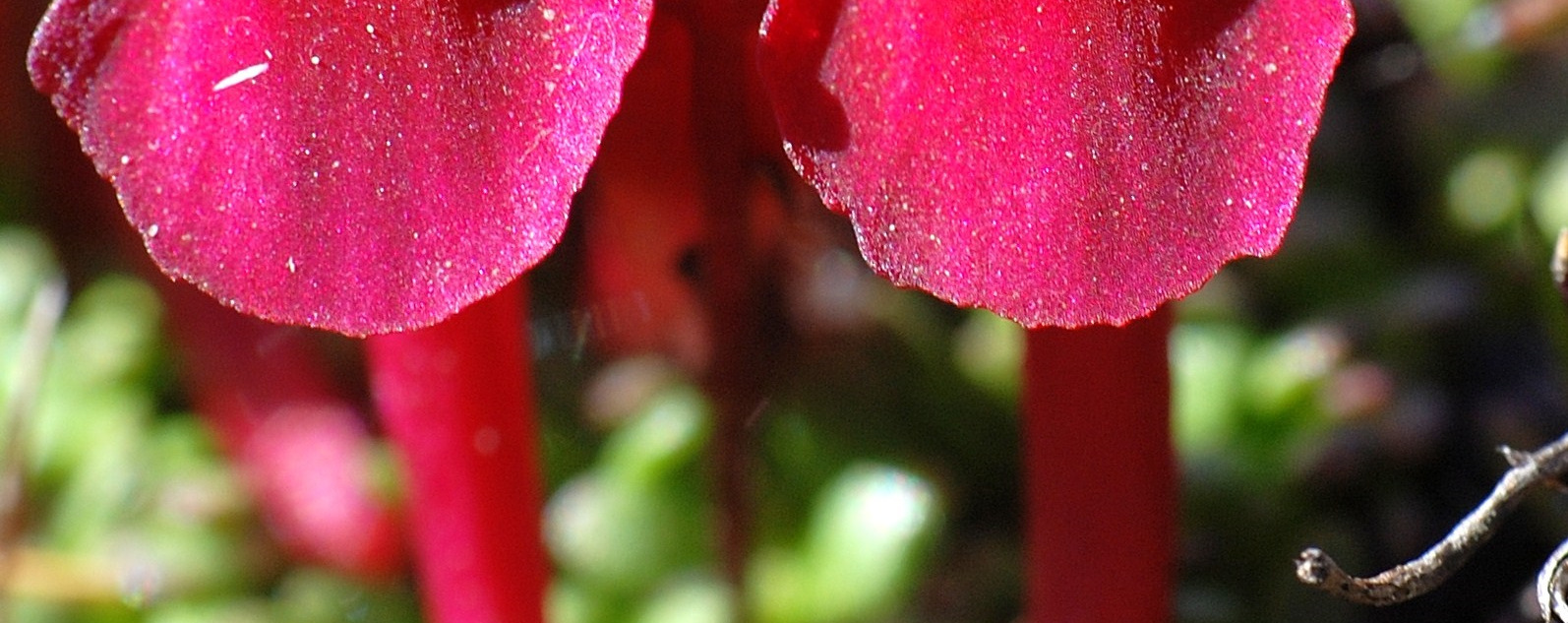
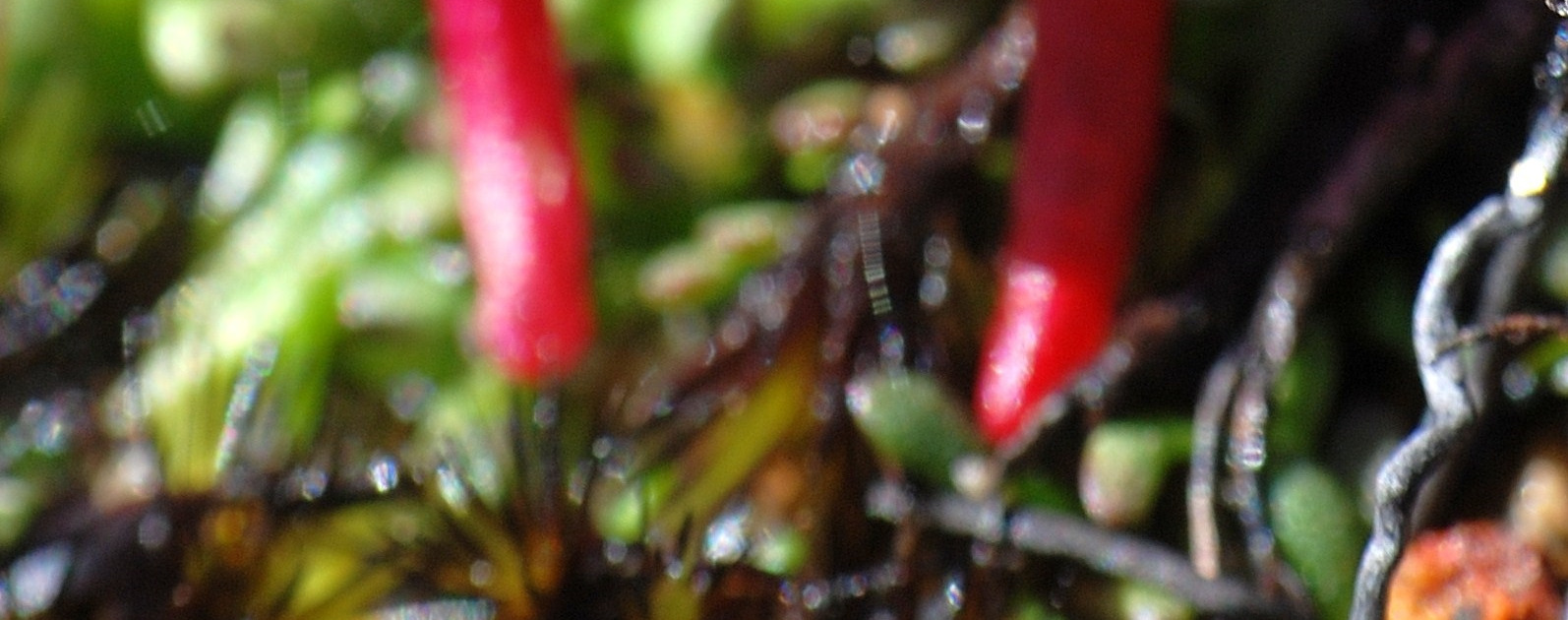
NATCH GREYES
rewetting of the ground, Utricularia
menziesii sprouts a number of small,
fleshy green leaves, and produces
several of its famous red flowers. A
rare variant has pale pink flowers
instead of red. Another variant has red
leaves instead of green.
In the wild, Utricularia menziesii is
pollinated by the Western Spinebill
( Acanthorhynchus superciliosus). This bird
hops along the ground, inserting its
long, curved beak into the flower, and
gathers the waxy pollen on its beak. No
other Australian Utricularia is known to
be pollinated in the same manner.
Utricularia menziesii often inhabits
sandy-clay swamp flats that become dry
in the summer, in sandy peat on the
edges of swamps that dry during the
summer, on the edges of granite
outcrops, and in small depressions
often covered with moss.
In cultivation, this species ought
to be treated like a tuberous Drosera.
The potting mix should be two parts
long-fiber
sphagnum,
one
part
sphagnum
peat,
and
one
part
vermiculite. As with tuberous Drosera, it
needs to be kept cool and exposed to a
short photoperiod in order to be
induced to flower. Note, however, that,
in order for Utricularia menziesii to
flower, it must be several years old and
possess a small cluster of tubers.
(Unlike tuberous Drosera, one tuber
does not equal one plant with
Utricularia menziesii. Mature plants often
Utricularia menziesii in flower. It is more commonly known
consist of small clusters of tubers).
as “Red Coats” in its native Australia.51
U. odorata
Known for its yellow flowers and pleasant aroma, Utricularia odorata is native to southeast Asia and
Northern Australia, where it grows in large swarms in wet grasslands. It is relatively rare in cultivation, but has
become more common in recent years. Oftentimes, it performs best in cultivation in the wetter areas of bog
gardens, where it can expand to create a small field of flowers. Its prolific nature means that it is a risky plant
in terms of spreading into natural boggy areas as a non-native invasive.
189
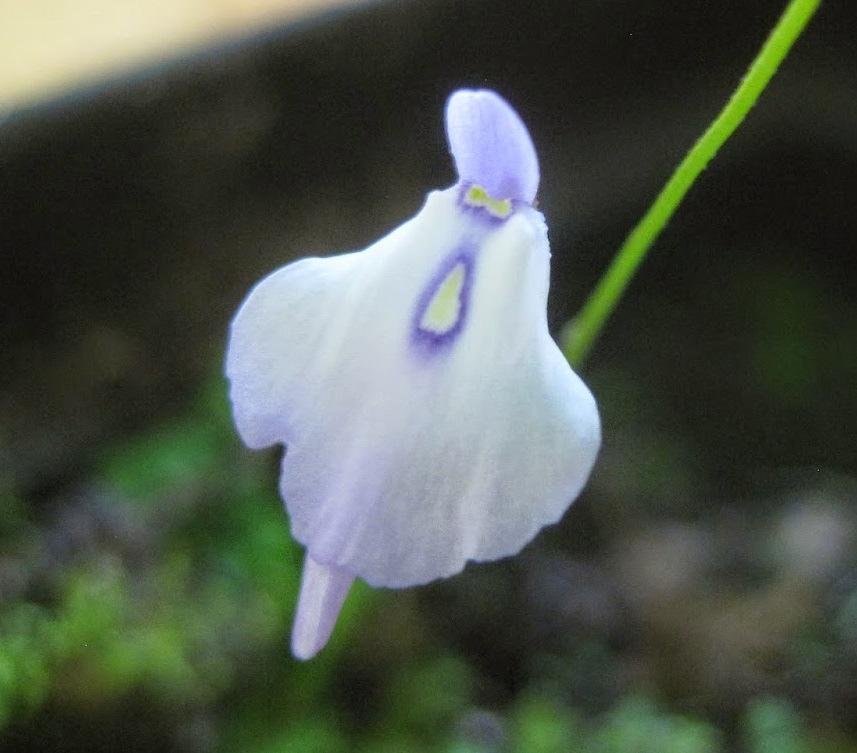
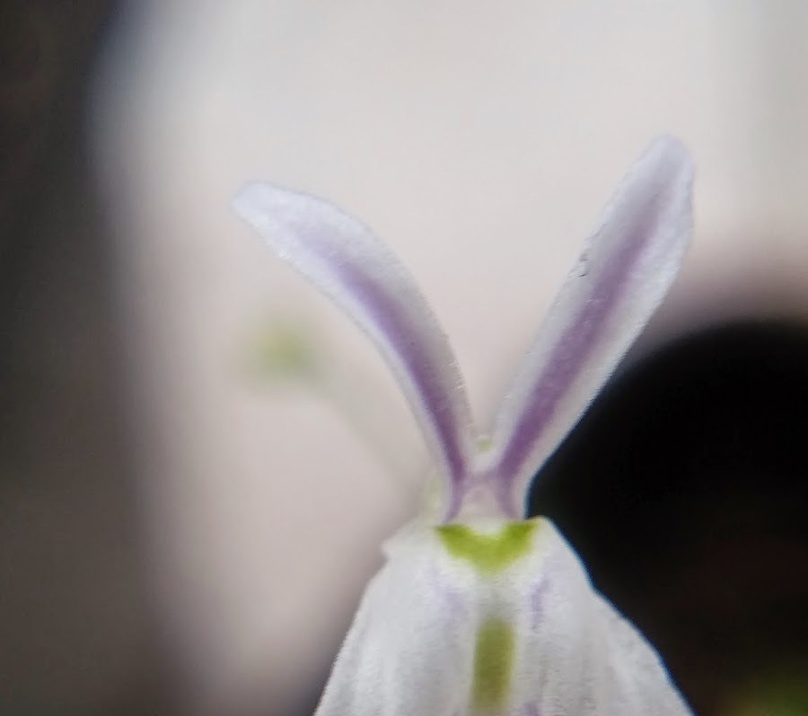
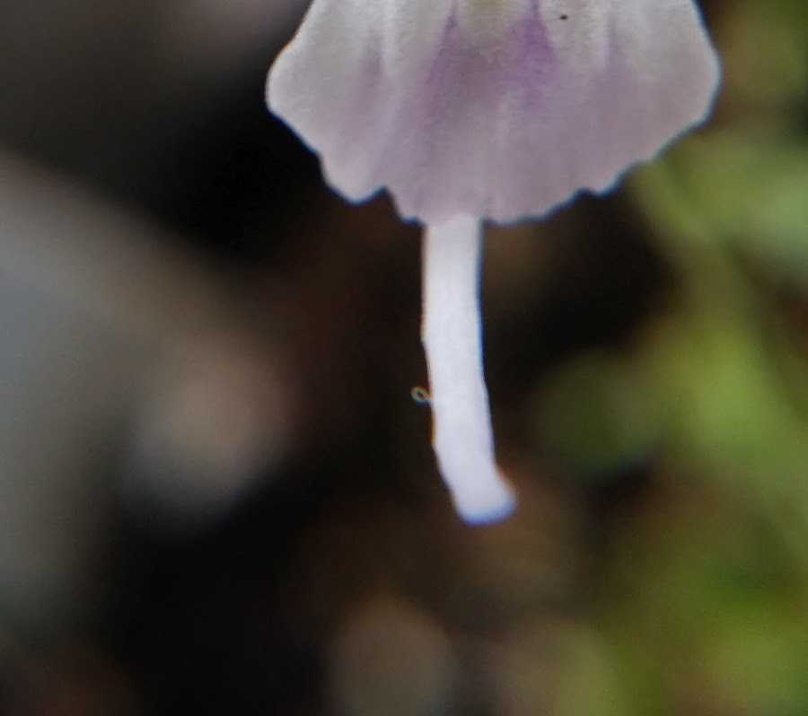
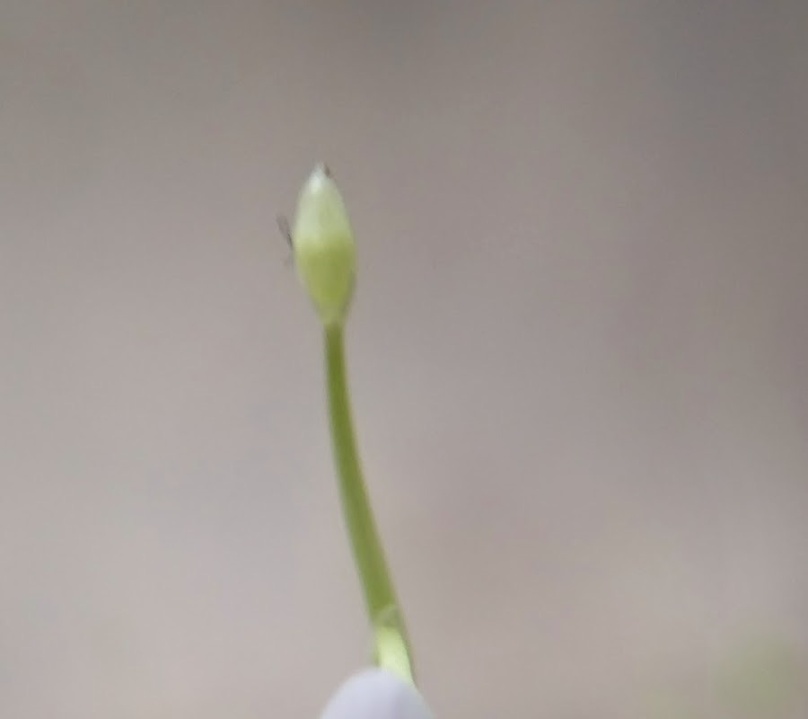
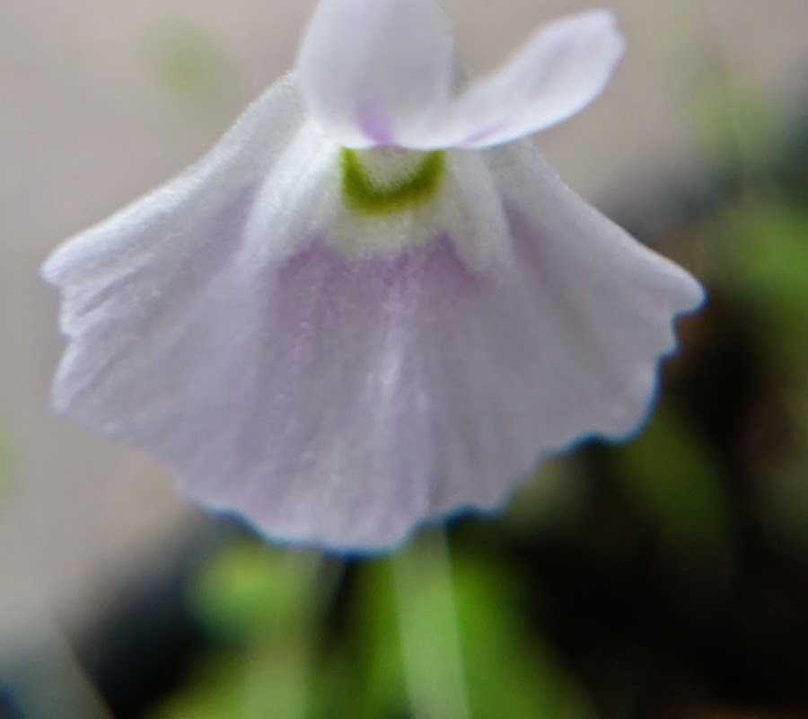
CULTIVATING CARNIVOROUS PLANTS
U. pubescens
The
Bull’s-Eye
Bladderwort,
Utricularia pubescens, is a favorite
terrestrial Utricularia among growers.
Its
leaves
are
distinctive
and
unmistakable. They are round and
tiny, almost like miniature lily pads
among the moss. This roundness is
repeated in the flower, which is, for
the most part, white and shaped very
much like Utricularia livida. The
roundness comes in on the center of
the flower, where a purple bull’s-eye
floats.
Utricularia pubescens is an easy
Utricularia to grow. As with other
terrestrial Utricularia, it prefers a
sphagnum peat-heavy mix. Flowering
can be reliably induced by allowing
the water level to rise, as it would in
spring time as a result of the spring
rains, and keeping it at a high level.
After flowering, let the water level
fall, so the plant may rest and store
Utricularia pubescens flower.
energy for the next flowering cycle.
U. sandersonii
The famous “Angry Bunny” is the most
desired,
widely-available
Utricularia
in
cultivation. It comes in two forms - typical
and “blue.” The typical form has flowers
that look like the face of a rabbit. They are
white with light lavender outlining the inside
of the ears and mouth. Yellow highlights
color in the eyes. The “blue” form is similar.
Its “bunnies” have a wider “face” and are
darker in color. It is less apt to flower than
the typical form.
Flowering can be induced by allowing
the water level to rise as it would naturally in
the springtime. Unlike other terrestrial
Utricularia, Utricularia sandersonii is slow to
spread. Oftentimes, it will produce aerial
stolons and spread to new pots, instead of
spreading within its own pot.
Utricularia sandersonii
Utricularia sandersonii “Blue”
190

NATCH GREYES
U. subulata
The little yellow airplane flowers of Utricularia
subulata are well known to carnivorous plant collectors.
This loveable little weed grows, naturally, across much
of the world. In cultivation, it grows in nearly every
collection.
Oftentimes, the tiny, needle thin leaves are
confused with other species, such as Utricularia
blanchetii, but the giveaway is, almost always, the
cleistogamous flowers. These are non-opening, self-
pollinating flowers. A single specimen of Utricularia
subulata can have dozens of them. No other Utricularia
produces as many as frequently. In fact, it is rare for
this perpetually flowering species to actually produce its
little yellow airplane flowers.
Utricularia subulata is the definition of a weed. It
will grow in any conditions, and any attempt to root it
out of a collection is fruitless as its tiny, black seed is as
Utricularia subulata flower.
small as the head of a pin.
My standard growing guide for terrestrial Utricularia follows:
✵
Media: Most terrestrial Utricularia are very tolerant of potting media, but most seem to prefer a
sphagnum-peat heavy mix. Two parts sphagnum peat to one part perlite usually works well. Note,
however, that species from Western Australia, such as the tuberous Utricularia menziesii, and species
from the southeastern United States often grow in extremely sandy soil in the wild. Although most of
these species seem to grow well in a heavy-sphagnum peat mixture, if they are not spreading
adequately, consider switching to a sandier mix.
Over time, terrestrial Utricularia will decline due to the degradation of the potting media.
Unfortunately, unlike other carnivorous plants, most terrestrial Utricularia are not easily separable
from their media. Therefore, the only real way to “refresh” media is to repot small plugs of the
Utricularia in new media. This does have the disadvantage of setting the plant back, but is a necessary
step for those who grow their plants inside or in artificial bogs which do not see as much nutrient
exchange as occurs in real bogs.
✵
Moisture: Despite their terrestrial nature, there’s really no such thing as too much water for terrestrial
Utricularia. Many growers prefer to grow them in undraining pots or glass containers and allow the
water level to rise above the level of the medium. This normally causes an unsightly algae and slime
mold buildup. To avoid that mess, use regular pots and water these via the tray method. By allowing
the water level to rise and fall, but never dry out completely, some species will be induced to flower
and unsightly (and stinky) algae can be avoided. Some species are more apt to flower if, after a month
or two of low water levels, the pots are almost submerged by high water levels. Other species are
more apt to flower after the water levels are allowed to fall after being flooded for a few weeks. By
alternating low and high water levels plants will be allowed to rest between flowering periods, and the
majority of terrestrial species can be induced to flower within a six month period. Note, however,
that in collections where algae is a problem, the plants should be allowed to dry out more, media
should be refreshed as stated above, and as much algae removed from the environment as possible.
191
CULTIVATING CARNIVOROUS PLANTS
✵
Humidity: Humidity is often a key factor for inducing or maintaining flowering. (This is only true in
some species, however). In several home experiments, some species, such as Utricularia pubescens and
Utricularia livida flowered nearly non-stop when humidity was high, but were less prolific when
humidity was low. Other species, such as Utricularia subulata, are more likely to produce
cleistogamous, i.e. self-pollinating, flowers in low humidity conditions. Given that, in the wild, most
species flower in spring, when rainstorms are frequent, humidity is likely important for inducing
successful flowering.
✵
Pot Size: Terrestrial Utricularia will spread to fill any sized pot via underground stolons. After filling
their pot, some will even send out aerial stolons in an attempt to expand past the edge of the pot.
( Utricularia sandersonii is well known for this phenomenon). Therefore, growers should keep a
watchful eye on collections to make sure their plants do not spread too far.
Growers who introduce terrestrial Utricularia to their outdoor collections or bog gardens should be
careful to keep watch on surrounding wetlands which could play host to Utricularia species. Many
terrestrial species are prone to prolific seed production in good conditions, and the find, dust-like
seed can easily be blown quite far in the wind, meaning that terrestrial Utricularia can easily spread to
suitable nearby environments. Therefore, growers who have terrestrial Utricularia outside should
remain cognizant of the fact that they could easily colonize nearby native environments and,
potentially, push out native carnivorous plants or other species.
✵
Feeding: It is extremely difficult to successfully introduce microorganisms to terrestrial media on
purpose without introducing all sorts of pests as well. As a consequence, many growers avoid
attempting to introduce new microorganisms for their plants to eat. This is probably a sound
practice, although microorganisms will, eventually, enter into the terrestrial media on their own. I’ve
found that regular fertilizing every few weeks with a foliar fertilizer designed for orchids can
dramatically promote plant growth. I’m not sure of its effect on flowering, but fertilizing does seem
necessary for maintaining flowering, and will result in larger, more sustained blooms.
✵
Temperature: Subtropical temperatures work well for most terrestrial Utricularia. Keeping the plants
in the 55° - 90° F (13° - 32° C) range is ideal, and can prevent annuals from dying off due to
temperature fluctuations. Note, however, that that is not an exclusive range. Some Australian species,
such as Utricularia fulva, prefer temperatures above 70° F (21° C). Other species, such as the
ubiquitous Utricularia subulata require cold dormancy in order to flower, if they originate from more
northern climates.
✵
Dormancy: The need for dormancy will depend on the species, but most species, even annuals, can
be grown without dormancy. Plants originating from more temperate climates, however, may require
dormancy in order to flower successfully.
✵
Propagation: The easiest way to propagate terrestrial Utricularia is just to tear off a section of the plant
while it is growing. This “plug” will grow to fill whatever size pot it is placed in. Some species, such
as Utricularia subulata are good candidates for growth from seed, but most terrestrial Utricularia seed is
so small and short lived that it is impractical to collect, store, and sew. The major exception to this
rule is annual species, which, although having small seed, often have fairly tough and long lived seed.
This makes it possible for Utricularia chrysantha, for instance, to grow in a bog garden in New England
all summer, die off in the cold winter, and come back from seed in the spring.
192














NATCH GREYES
Epiphytic Utricularia
Utricularia alpina52
The most desired of all Utricularia are the epiphytic type from South America. These large plants include
the showy Orchidioides section, which is well known for its large, showy flowers. Many Orchidioides Utricularia
can grow to be very large before flowering. Some near the size of medium sized Nepenthes. In ideal conditions,
species from this section can unfurl new leaves at a fairly rapid rate and will flower annually. In less than ideal
conditions they will be very slow growers, and producing one new leaf every few months.
Many epiphytic Utricularia grow in cloud forests and atop Tepuis alongside Heliamphora. In these
conditions, they experience cool temperatures, and bright sun. High humidity or rainfall is a constant. To
avoid being swept away by the torrents of water that pour off the sides of the Tepuis, or desiccate in periods
of dryness, epiphytic Utricularia often grow small pools of water, including, sometimes, the water filled cups
of bromeliads, the moss alongside Heliamphora, on bark, or in decaying leaves on rocks or in the nooks of
trees.
Almost all epiphytic Utricularia have a pseudo-dormancy, i.e. a period of slower growth. For some
species, this pseudo-dormancy can last as long as six months. During this period, very few new leaves will
193
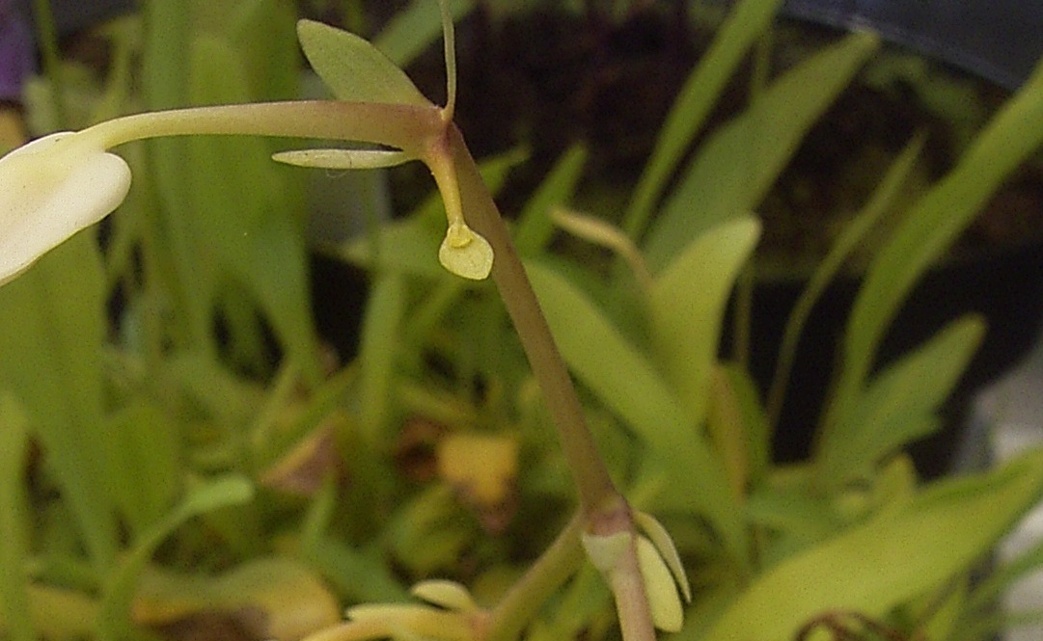
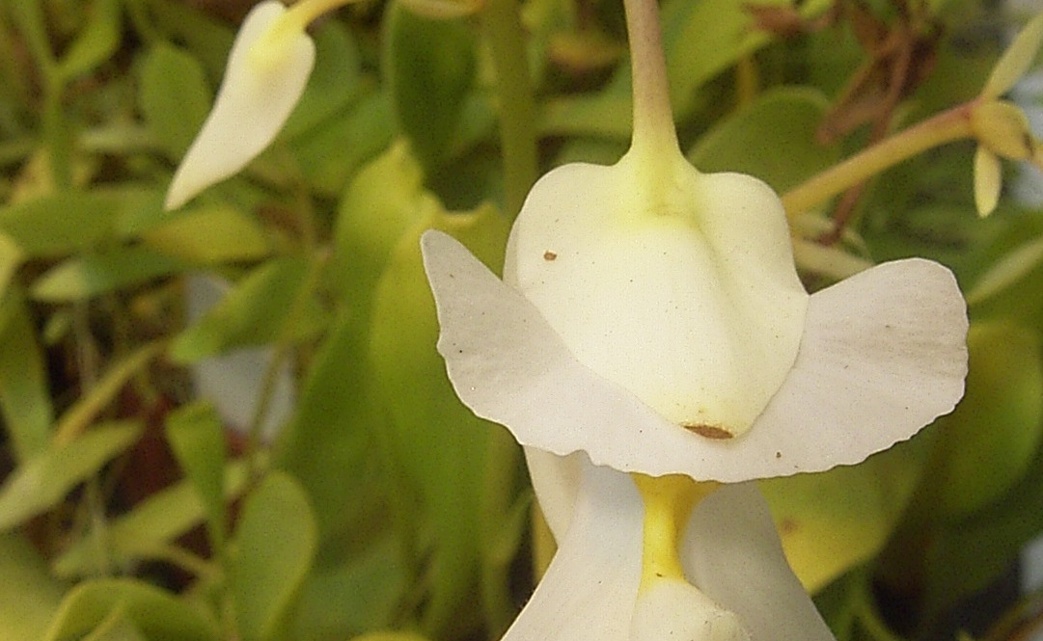
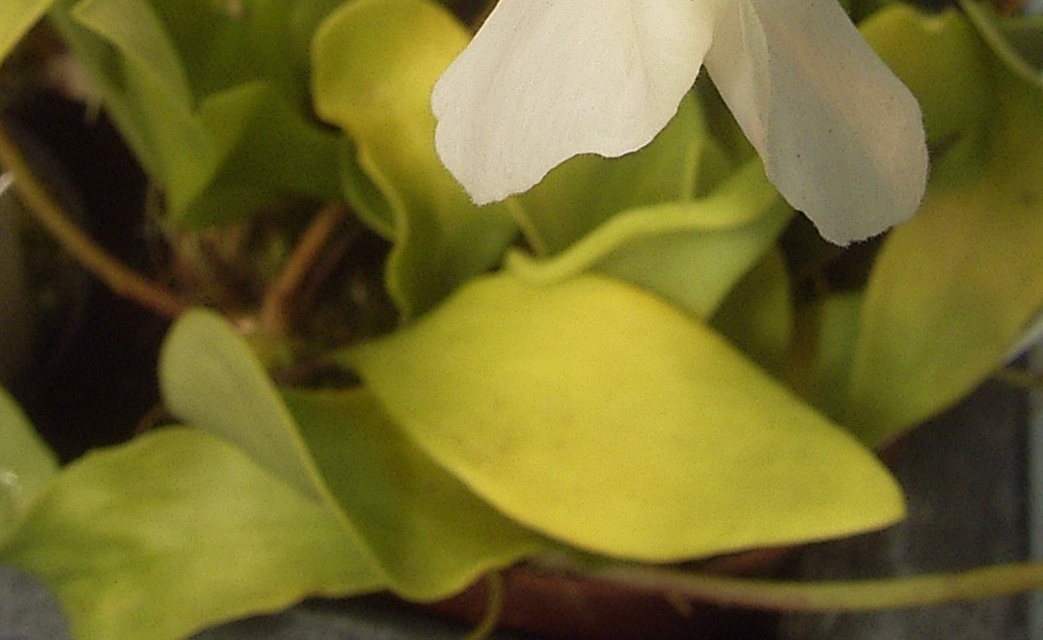







CULTIVATING CARNIVOROUS PLANTS
appear, but there is some growth occurring under the surface of the
potting media. In the wild, this pseudo-dormancy occurs in
conjunction with the dry season. Some species, such as Utricularia
alpine, grow underground tubers to survive the dry season.
In many respects, epiphytic Utricularia should be treated like
orchids. They prefer light, airy media, net pots, top watering, and
being kept slightly drier than other species of Utricularia. During
their pseudo-dormancy they should be kept even drier, although
humidity should always remain as high as possible. Even during
pseudo-dormancy, the media should never be allowed to dry out
completely.
Many epiphytic Utricularia have been hybridized. These hybrids,
almost inevitably, exhibit significant hybrid vigor, making them
some of the most popular plants in cultivation. Given the wide
availability of hybrids, this section will address several popular
hybrids in addition to pure species.
U. alpina
Utricularia alpina is native to the Antilles and northern South
America. Among the species of epiphytic Utricularia, it is one of the
easiest. It prefers to grow in one part long-fiber sphagnum and one
part perlite. During it active growing period, it should sit in a pot of
water, but should be kept drier during its dormant period. It should
be potted in an oversized pot to allow the media to avoid being
Utricularia alpina53
saturated.
U. alpina x endresii
Utricularia alpina x endresii is a popular cross exhibiting
great hybrid vigor. It has large, green leaves, and spreads
rapidly under its potting media via horizontal stolons. The
leaves appear, at first, to unfurl from an underground
growth point, then rapidly expand in size.
This hybrid is one of the few epiphytic Utricularia that
grows well in a mix of one part long-fiber sphagnum moss
and one part orchid bark, rather than a mixture involving
live sphagnum. It is also one of the few that does well in
waterlogged conditions, although those conditions are not
preferable. As with other epiphytic Utricularia, it requires
cool conditions to grow well.
The flowers are large, white or pale pink, and showy.
This hybrid is more apt to flower than other members of
the epiphytic Utricularia group, probably as a consequence
of its hybrid parentage.
Utricularia alpina x endresii54
194







NATCH GREYES
Utricularia quelchii in the wild.55
195
CULTIVATING CARNIVOROUS PLANTS
U. ‘Jitka’
Utricularia ‘Jitka’ is a hybrid between Utricularia quelchii and Utricularia praetermissa. It has elliptical leaves,
pointed at each end. It prefers to grow in live sphagnum, and, in warm conditions, it is a remarkably slow
grower. Net pots and a constantly wet conditions are ideal for this cultivar. It does not like waterlogged
conditions, however, and will do poorly. Unlike some other epiphytic Utricularia, it prefers somewhat shaded
conditions.
The flowers are large and pink with a prominent yellow blotch. They are infertile, as are many hybrids,
yet showy. Several flowers will open in succession, unlike some epiphytic Utricularia which only produce a
flower or two per stalk.
My standard growing guide for epiphytic Utricularia follows:
✵
Media: One part New Zealand long-fiber sphagnum and one part perlite or orchid bark works well
for epiphytic Utricularia. Live sphagnum also works well, especially if coupled with a handful of
orchid bark. Note that dead long-fiber sphagnum will, over time, break down, resulting the plant
growing in either pure perlite or orchid bark, which is not ideal for growth. As such, epiphytic
Utricularia should be repotted every few years.
✵
Moisture: Epiphytic Utricularia do not like to be waterlogged, unlike other types of Utricularia. Top
watering seems to be preferable, if possible. Avoid allowing the pot to sit in water. Allow the media
to become just barely damp to the touch before watering again.
✵
Humidity: As with other natives of cloud forests, high humidity is important for epiphytic Utricularia
to grow well. The best way to achieve high humidity when the epiphytic Utricularia are young is in a
terrarium. Larger specimens may necessitate a greenhouse or specialty built terrarium.
✵
Pot Size: Net pots are recommended to allow for good airflow around the stolons of epiphytic
Utricularia. Over time, these plants will grow to fill any sized pot. After the pot has been filled, it may
send out aerial stolons in an attempt to expand past the edge of the pot.
✵
Feeding: It is extremely difficult to successfully introduce microorganisms to epiphytic media. As a
consequence, most growers do not attempt to feed their epiphytic Utricularia. On accident, I used a
foliar spray of diluted, seaweed-based, foliar, orchid fertilizer on some epiphytic Utricularia. Within a
few weeks I saw a dramatic increase in growth. Subsequently, I have been regularly fertilizing my
plants every few weeks and have seen much better growth than previously.
✵
Temperature: As epiphytic Utricularia are native to cloud forest and Tepuis, temperatures should be
the same as highland Nepenthes or Heliamphora, in the 60° - 80° F (16° - 27° C) range. Do not let
temperatures exceed 80° F (27° C).
✵
Dormancy: The need for dormancy depends on the species, but most species will enter a pseudo-
dormancy during which visible growth slows. During this time period, watering should decrease,
although humidity should remain high.
✵
Propagation: The easiest way to propagate epiphytic Utricularia is the same as terrestrial Utricularia,
division. The best way to do this is to tear off a section of the plant and place this “plug” in a new
pot. Note that division of epiphytic Utricularia will slow growth more than with terrestrial Utricularia.
It is possible to grow epiphytic Utricularia from seed, but this remains viable for only about a month.
As a consequence, it is extremely difficult to obtain seed that is likely to germinate. If seed is
obtained, it should be sewn on milled sphagnum until it germinates, much like with Nepenthes.
The following table of all known Utricularia species includes their distribution, habitat, type, and notes on
the species in order to facilitate thoughts on care:
196
NATCH GREYES
Species
Distribution
Habitat
Type
Habitat / Notes
Wet sandy savannas at altitudes from
adpressa
South America
Terrestrial
Annual
sea level to 4,101 ft. (1,250 m).
Queensland,
albiflora
Australia
Terrestrial
Perennial
Maharashtra,
albocaerulea
India
Terrestrial
Annual
Damp areas and wet rocks.
The Antilles
and northern
alpina
South America
Epiphytic
Perennial
Cultivate in live sphagnum.
Western
Queensland,
ameliae
Australia
Terrestrial
Perennial
Discharge mound springs.
Bolivia, Brazil,
Guyana, Peru,
and Southeast
amethystina
Florida
Terrestrial
Perennial
Wet, bare rocks or mosses in
grasslands at altitudes from 787 -
andongensis
Tropical Africa
Terrestrial
Perennial
5,906 ft. (240 - 1,800 m).
Western
Gravel or sand in seepage areas on
antennifera
Australia
Terrestrial
Annual
top of sandstone.
Wet Sphagnum bogs, damp sandy
savannas, or in peaty marshes at
altitudes from 4,921 - 6,102 ft. (1,500
appendiculata
Tropical Africa
Terrestrial
Perennial
- 1,860 m).
arcuata
India
Terrestrial
Annual
Seasonally wet depressions.
Damp, sandy or peaty soils in
swampy grasslands or marshes at
altitudes from sea level to 7,874 ft.
arenaria
Tropical Africa
Terrestrial
Annual
(2,400 m).
Arnhem Land
Area, Northern
Cultivate in sandy-peat media with
Territory,
high water level, full sun, and high
arnhemica
Australia
Terrestrial
Perennial
daytime temperatures.
Colombia and
asplundii
Ecuador
Terrestrial
Epiphytic
India to Japan
aurea
and Australia
Aquatic
Perennial
Rice paddies.
Ptari-tepuí and
aureomaculata
Amaruay-tepuí
Terrestrial
Perennial
Moist, mossy bluffs.
australis
Nearly Global
Aquatic
Perennial
197
CULTIVATING CARNIVOROUS PLANTS
In and near small streams in open
forests at altitudes from 2,297 - 2,953
ft. (700 - 900 m) or on wet rock faces
Kolhapur
among mosses at an altitude of 5,413
District, India,
ft. (1,650 m); often mistaken for U.
babui
and Thailand
Terrestrial
Perennial
graminifolia.
Victoria,
barkeri
Australia
Terrestrial
Perennial
Often mistaken for U. dichotoma.
Victoria and
New South
beaugleholei
Wales, Australia Terrestrial
Perennial
Often mistaken for U. dichotoma.
Guyana,
Surinam,
Very calm waters with at least 1 foot
Tropical Africa,
(30 cm) water; inflated “wheels” like
Madagascar,
U. inflata or U. radiata, but with
benjaminiana
Trinidad
Aquatic
Perennial
purple flowers.
Lake Muir,
Australia,
Manjimup,
Australia, and
Bridgetown,
Swamps and wet flats with a soil of
benthamii
Australia
Terrestrial
Annual
clay or peat.
bifida
Southeast Asia
Terrestrial
Annual
Damp soils, usually in rice paddies.
New South
Wales and
Queensland,
biloba
Australia
Terrestrial
Perennial
biovularioides
Brazil
Aquatic
Annual
Angola,
Lesotho,
Damp, sandy, or peaty soils among
Madagascar,
mosses by streams or wet
Namibia, and
depressions at altitudes from sea
bisquamata
South Africa
Terrestrial
Annual
level to 7,381,890 ft. (2,250 km).
Ephemeral wetland habitat at
altitudes from 656 - 2,952 ft. (200 -
Undara,
900 m); often confused with U.
blackmanii
Australia
Terrestrial
Perennial
dichotoma.
Damp, sandy soils, among rocks, or
by streams at altitudes from 2,789 -
blanchetii
Bahia, Brazil
Terrestrial
Annual
1,750 m (850 - 5,741 ft.).
Ko Chang
bosminifera
Island, Thailand Terrestrial
Perennial
On sandy banks by streams.
Eastern
Himalaya
Among mosses on rocks at altitudes
Region and
from 8,530 - 13,780 ft. (2,600 - 4,200
brachiata
Yunnan, China
Terrestrial
Perennial
m).
198
NATCH GREYES
In similar habitat as U. bisquamata
and often confused with that species.
Single purple flower with single
lobed stigma per scape is
brachyceras
South Africa
Terrestrial
Annual
distinguishing.
Angola,
Zambia,
Democratic
Republic of the
Peaty grasslands at altitudes from
bracteata
Congo
Terrestrial
Perennial
3,281 - 4,921 ft. (1,000 - 1,500 m).
Central, Europe
and Western
bremii
Europe
Aquatic
Perennial
The Antilles
and South
breviscapa
America
Aquatic
Annual
Henri Pittier
National Park
and Paraguana
Mossy trees in montane forests at
Peninsula,
altitudes from 2,723 - 5,823 ft. (830 -
buntingiana
Venezuela
Epiphytic
Perennial
1,775 m).
Wet, shallow soils over rock, in wet
Tropical Africa
grasslands, in swamps, or near
and Southeast
streams in open communities at
caerulea
Asia
Terrestrial
Perennial
altitudes up to 6,890 ft. (2,100 m).
Brazil, Guyana,
Suriname, and
calycifida
Venezuela
Terrestrial
Perennial
Cultivate in live sphagnum moss.
Tree trunks, branches, and aerial
roots of Bonnetia species at altitudes
Guyana and
from 4,921 - 8,202 ft. (1,500 - 2,500
campbelliana
Venezuela
Epiphytic
Perennial
m).
Darwin,
capilliflora
Australia
Terrestrial
Annual
Mangalore,
Karnataka,
Damp, shallow soils on top of
cecilii
Australia
Terrestrial
Annual
laterite.
Arnhem Land
Escarpment,
cheiranthos
Australia
Terrestrial
Perennial
chiakiana
Venezuela
Aquatic
Perennial
Wet, sandy savannas, or marshes at
Colombia and
altitudes from 262 - 5,906 ft. (80 -
chiribiquitensis
Venezuela
Terrestrial
Annual
1,800 m).
199
CULTIVATING CARNIVOROUS PLANTS
Suriname and
Montagne des
Bare granite rocks in dripping water
Nouragues,
at altitudes from sea level to 2,953 ft.
choristotheca
French Guiana
Rheophyte
Perennial
(900 m).
Among mosses on rocks at altitudes
Himalaya
from 11,811 - 12,795 ft. (3,600 -
christopheri
Region
Terrestrial
Perennial
3,900 m).
Southern New
Guinea and
Wet grasslands or Melaleuca-Acacia
chrysantha
Australia
Terrestrial
Annual
savannas at low elevations.
Swamps, streams, or lagoons, usually
in shallow water in the company of
Northeastern
tall grasses and sedges, which its
circumvoluta
Australia
Terrestrial
Annual
inflorescence twines up.
On mossy rocks within range of the
cochleata
Goiás, Brazil
Terrestrial
Perennial
spray of a waterfall.
Black soil swamp based upon a
Minnamoolka,
basalt and sand substrate at an
corneliana
Australia
Aquatic
Perennial
altitude of 2,296 ft. (700 m).
Wet grasslands or, sometimes, in the
water-filled axil of a bromeliad at
Serra dos
altitudes from 2,461 - 6,234 ft. (750 -
cornigera
Órgãos, Brazil
Terrestrial
Perennial
1,900 m).
Bahamas, Cuba,
Marshes, swamps, and pools in
and North
shallow waters, mostly at lower
cornuta
America
Terrestrial
Perennial
altitudes.
Burma and
On wet granite rock faces at altitudes
corynephora
Thailand
Terrestrial
Perennial
from 591 - 2,461 ft. (180 - 750 m).
Brazil and
Damp soils among rocks in
costata
Venezuela
Terrestrial
Annual
savannas.
Brazil, French
Guiana,
Guyana,
Suriname,
Trinidad, and
cucullata
Venezuela
Aquatic
Perennial
Tropical and
cymbantha
South Africa
Aquatic
Annual
delicatula
New Zealand
Terrestrial
Perennial
Elevations below 656 ft. (200 m).
Swamps and rice paddies, wet
Cambodia,
grasslands, or open pine forests at
Laos, Thailand,
altitudes from sea level up to 4,265
delphinioides
and Vietnam
Terrestrial
Perennial
ft. (1,300 m).
200
NATCH GREYES
Chapada dos
Veadeiros
Occurs with Eriocaulon aff. heteropeplon
National Park,
in shallow pools of water deep
densiflora
Brazil
Terrestrial
Perennial
among grasslands.
Wilhelmina
On bare granite rocks in dripping
Mountains,
water at altitudes from sea level up to
determannii
Suriname
Rheophyte
Perennial
2,953 ft. (900 m).
New Caledonia,
Bogs, ephemeral lakes, seepages in
Australia, and
peat lands, and margins of sandy
dichotoma
New Zealand
Terrestrial
Perennial
lakes in alpine bogs and tarns.
dimorphantha
Japan
Aquatic
Perennial
Western and
Northern
dunlopii
Australia
Terrestrial
Annual
Western and
Wet sand, often in shallow water, in
Northern
Melaleuca nervosa woodland or
dunstaniae
Australia
Terrestrial
Annual
Verticordia shrub land.
Costa Rica,
Panama,
Colombia, and
endresii
Ecuador
Epiphytic
Perennial
Wet, sandy savannas, wet grasslands,
erectiflora
South America
Terrestrial
Perennial
or marshes.
Lake Eyre
fenshamii
Basin, Australia
Terrestrial
Perennial
Mound springs.
Damp, sandy soils in savannas at
Colombia and
altitudes from sea level up to 984 ft.
fimbriata
Venezuela
Terrestrial
Perennial
(300 m).
Damp, sandy or peaty soils in
grasslands, or wet, mossy rocks at
altitudes from sea level up to 6,890
Tropical and
ft. (2,100 m); often a weed in rice
firmula
South Africa
Terrestrial
Annual
paddies.
Western
fistulosa
Australia
Aquatic
Perennial
Cultivate in flooded substrate with
high light. Prefers summer
flaccida
Brazil
Terrestrial
Perennial
temperatures of 65° F (18° C).
Southeastern
floridana
United States
Aquatic
Perennial
Africa, North
America, and
foliosa
South America
Aquatic
Perennial
201
CULTIVATING CARNIVOROUS PLANTS
Northern
On rocks among mosses at altitudes
Burma and
from 6,890 - 9,843 ft. (2,100 - 3,000
forrestii
Western China
Terrestrial
Perennial
m).
Tropical Africa
and Southeast
Wet soils or in shallow water;
foveolata
Asia
Terrestrial
Perennial
sometimes a weed in rice paddies.
Arnhem Land
Sandstone
Escarpment,
fulva
Australia
Terrestrial
Perennial
In or near sandy stream beds.
On moist rocks at altitudes from
furcellata
Northeast India
Terrestrial
Annual
4,921 - 8,858 ft. (1,500 - 2,700 m).
On moist rocks at altitudes around
7,136 ft. (2,175 m); often confused
garrettii
Thailand
Terrestrial
Perennial
with U. striatula.
geminiloba
Brazil
Terrestrial
Perennial
Altitudes from 1,395 - 6,562 ft. (425
Serra dos
- 2,000 m). Cultivate in moist soil
Orgaos
year-round, with indirect sunlight,
Highlands,
high air humidity, and temperatures
geminiscapa
Brazil
Epiphytic
Perennial
between 50° - 77° F (10° - 25° C).
Among short grasses in or around
rice paddies at altitudes from sea
geoffrayi
Indochina
Terrestrial
Perennial
level up to 4,265 ft. (1,300 m).
Western
georgei
Australia
Terrestrial
Annual
gibba
Near Global
Aquatic
Perennial
Burma, China,
Wet soils or in marshes at altitudes
India, Sri Lanka, Terrestrial/
from sea level up to 4,921 ft. (1,500
graminifolia
and Thailand
Aquatic
Perennial
m).
Grampians
National Park,
and Langi
Ghiran State
grampiana
Park, Australia
Terrestrial
Perennial
Often confused with U. dichotoma.
Central and
Wet or damp sandy savannas from
guyanensis
South America
Terrestrial
Perennial
sea level up to 3,609 ft. (1,100 m).
Northern
Territory,
hamiltonii
Australia
Aquatic
Perennial
Western
helix
Australia
Aquatic
Annual
202
NATCH GREYES
Ptari-tepuí,
Toronó-tepuí,
Apacara-tepuí,
Serrania
Guanay, and
Wet sandstone cliffs near waterfalls
Chimantá
among mosses at altitudes from
heterochroma
massif.
Rheophyte
Perennial
5,774 - 8,038 ft. (1,760 - 2,450 m).
Palawan,
Shallow water or creeks at altitudes
Luzon, and
near sea level; often confused with
heterosepala
Sibuyan
Aquatic
Perennial
U. graminifolia.
Southwest of
Mexico City,
hintonii
Mexico
Terrestrial
Annual
Wet soils or on rocks.
Damp or wet open areas or marshes
India and
at altitudes from sea level up to 3,281
hirta
Southeast Asia
Terrestrial
Perennial
ft. (1,000 m).
Central and
Any wet, muddy area free from other
hispida
South America
Terrestrial
Perennial
vegetation.
Northern
Territory,
holtzei
Australia
Aquatic
Annual
On tree trunks, in shallow water, or
Brazil, Guyana,
wet soil in open savanna at altitudes
humboldtii
and Venezuela
Epiphytic
Perennial
of 3,937 - 8,202 ft. (1,200 - 2,500 m).
Central
Brazilian
huntii
Uplands
Terrestrial
Perennial
Tropical North
America and
Tropical South
hydrocarpa
America
Aquatic
Annual
Western
inaequalis
Australia
Terrestrial
Annual
Often confused with U. dichotoma.
incisa
Cuba
Aquatic
Perennial
Lakes, ditches, and swamps of any
Southeastern
depth at altitudes near sea level;
inflata
United States
Aquatic
Perennial
invasive in temperate areas.
inflexa
Africa and India Aquatic
Perennial
Asia, North
America, and
Cultivate in a manner that provides
intermedia
Europe.
Aquatic
Perennial
cold dormancy in winter.
Doi Inthanon
Moist granite rocks at altitudes
National Park,
around 5,413 ft. (1,650 m);
inthanonensis
Thailand
Terrestrial
Perennial
commonly confused with U. garrettii.
203
CULTIVATING CARNIVOROUS PLANTS
Wet grasslands or open vegetation at
Southeastern
altitudes from sea level to 2,953 ft.
involvens
Asia
Terrestrial
Perennial
(900 m).
Wet rocks at an altitude of around
7,218 ft. (2,200 m), or in evergreen
jackii
Thailand
Terrestrial
Perennial
forests.
Mossy tree trunks in montane cloud
The Antilles
forests or lowland rain forests at
and South
altitudes from sea level up to 8,202
jamesoniana
America
Epiphytic
Perennial
ft. (2,500 m).
Often confused with U. chrysantha;
Northern
differs by having pinkish-lilac corolla
jobsonii
Australia
Terrestrial
Annual
with two large yellow or white spots.
North America
Marshes, swamps, and pools in
and South
shallow waters at altitudes near sea
juncea
America
Terrestrial
Perennial
level.
Darwin,
kamienskii
Australia
Terrestrial
Annual
Kimberley,
kenneallyi
Australia
Terrestrial
Annual
Northwestern,
kimberleyensis
Australia
Terrestrial
Perennial
India, and
Mossy rocks or in bog grasslands at
Yunnan
altitudes from 7,382 - 13,780 ft.
kumaonensis
Province, China Terrestrial
Annual
(2,250 - 4,200 m).
Goiás, Brazil
Damp, sandy or gravelly soils at
and Minas
altitudes from 3,281 - 4,265 ft. (1,000
laciniata
Gerais, Brazil
Terrestrial
Annual
- 1,300 m).
Northern
lasiocaulis
Australia
Terrestrial
Annual
Southern
Australia and
Sandy or peaty soils in heathland at
lateriflora
Tasmania
Terrestrial
Perennial
altitudes near sea level.
Argentina,
Brazil,
Wet grasslands and at the margins of
Paraguay, and
pools at altitudes from sea level up to
laxa
Uruguay
Terrestrial
Annual
3,609 ft. (1,100 m).
Mangalore,
Shallow wet soils over laterite or in
lazulina
India
Terrestrial
Annual
wet grasslands.
North and
leptoplectra
West, Australia
Terrestrial
Perennial
North and
leptorhyncha
West, Australia
Terrestrial
Annual
Central African
Seasonally flooded grasslands at
letestui
Republic
Terrestrial
Annual
altitudes around 2,625 ft. (800 m).
204
NATCH GREYES
limosa
Southeast Asia
Terrestrial
Perennial
Often confused with U. fistulosa.
Western
Grows in similar habitats as that
linearis
Australia
Aquatic
Perrenial
species.
Tropical and
Boggy areas or shallow soils over
South Africa;
rock at altitudes from sea level up to
livida
Central America Terrestrial
Perennial
9,285 ft. (2,830 m).
Bolivia, Brazil,
Panama,
Wet sandy soils in savannas at
Suriname,
altitudes from sea level up to 1,969
lloydii
Venezuela
Terrestrial
Annual
ft. (600 m).
Brazil,
Colombia,
Guyana,
Suriname, and
Damp, sandy soils at altitudes from
longeciliata
Venezuela
Terrestrial
Perennial
sea level up to 4,593 ft. (1,400 m).
longifolia
Brazil
Terrestrial
Perennial
Western and
Wet sand, often in shallow water, in
Northern
Melaleuca nervosa woodland or
lowriei
Australia
Terrestrial
Annual
Verticordia shrub land.
Mountains of
Guinea and
Among wet rocks on the sides of
macrocheilos
Sierra Leone
Terrestrial
Annual
mountains.
North
American and
macrorhiza
Temperate Asia
Aquatic
Perennial
Wet rocks or in lateritic soils in the
Kasaragod
presence of Eriocaulon species and
malabarica
District, India
Terrestrial
Annual
grasses.
Mangshan
Mountains of
Hunan
Damp cliffs intermixed with mosses
mangshanensis
Province, China Terrestrial
Annual
at 2,460 ft. (750 m).
Bioko, São
Tomé, Príncipe,
Mossy tree trunks in rain forests at
Cameroon, and
altitudes from 1,640 - 6,890 ft. (500 -
mannii
Nigeria
Epiphytic
Perennial
2,100 m).
Western
menziesii
Australia
Terrestrial
Perennial
Goiás, Brazil
Bogs and seasonally flooded swamps
and Mato
and grasslands at altitudes from
meyeri
Grosso, Brazil
Terrestrial
Perennial
1,312 - 1,969 ft. (400 - 600 m).
205
CULTIVATING CARNIVOROUS PLANTS
Democratic
Republic of the
Damp, sandy, or peaty soils in
Congo and
grasslands at altitudes from 3,937 -
microcalyx
Zambia
Terrestrial
Annual
5,413 ft. (1,200 - 1,650 m).
Central African
Republic,
Guinea, Nigeria,
and Sierra
Among wet rocks at altitudes from
micropetala
Leone
Terrestrial
Annual
sea level up to 4,921 ft. (1,500 m).
North America,
Asia, and
minor
Europe
Aquatic
Perennial
Damp or wet open areas with muddy
or sandy soils at altitudes from sea
minutissima
Southeast Asia
Terrestrial
Perennial
level up to 6,890 ft. (2,100 m).
Campo Grande,
Creeks with shallow running water at
mirabilis
Venezuela
Rheophyte
Perennial
altitudes around 4,921 ft. (1,500 m).
Wet rocks at altitudes from 2,461 -
moniliformis
Sri Lanka
Terrestrial
Perennial
7,546 ft. (750 - 2,300 m).
Australia and
muelleri
New Guinea
Aquatic
Perennial
Wet rocks or open swampy meadows
with mosses at altitudes from 5,906 -
multicaulis
India and China Terrestrial
Annual
13,123 ft. (1,800 - 4,000 m).
Western
multifida
Australia
Terrestrial
Perennial
myriocista
South America
Aquatic
Perennial
Swampy ground by streams and wet,
Northern South
sandy savanna from sea level up to
nana
America
Terrestrial
Perennial
4,100 ft. (1,250 m).
Venezuela and
Slow-flowing or still waters at
naviculata
Brazil
Aquatic
Annual
altitudes near sea level.
Water filled axils of bromeliads and,
occasionally, water filled pitchers of
nelumbifolia
Brazil
Epiphytic
Perennial
Heliamphora.
Northern South
Attached to rocks in the shallows of
neottioides
America
Rheophyte
Perennial
swiftly moving water; mat-forming.
Wet, mostly vertical rocks in
montane forests at altitudes from
nephrophylla
Brazil
Terrestrial
Perennial
1,969 - 3,937 ft. (600 - 1,200 m).
Argentina,
Brazil,
Colombia,
Paraguay, and
nervosa
Venezuela
Terrestrial
Perennial
206
NATCH GREYES
nigrescens
Brazil
Terrestrial
Perennial
North America,
Asia, and
ochroleuca
Europe
Aquatic
Perennial
Democratic
Republic of the
Damp, peaty soils in grasslands at
Congo, Malawi,
altitudes from 4,265 - 7,218 ft. (1,300
odontosepala
and Zambia
Terrestrial
Perennial
- 2,200 m).
Wet grasslands at altitudes near sea
odorata
Southeast Asia
Terrestrial
Perennial
level.
North and
olivacea
South America
Aquatic
Annual
Brazil,
Colombia, and
oliveriana
Venezuela
Aquatic
Perennial
panamensis
Panama
Terrestrial
Perennial
Among mosses on rocks.
Damp, sandy soils over sandstone
rocks at altitudes from 1,640 - 4,921
parthenopipes
Bahia, Brazil
Terrestrial
Annual
ft. (500 - 1,500 m).
Western
paulineae
Australia
Aquatic
Perennial
Damp, sandy or peaty soils in
grasslands or shallow soils over rock
at altitudes from 4,921 - 6,890 ft.
pentadactyla
Tropical Africa
Terrestrial
Annual
(1,500 - 2,100 m).
Among mosses on wet rocks in hilly
peranomala
Guangxi, China
Terrestrial
Perennial
regions.
Chihuahua and
Guanajuato,
Shallow pools of water at altitudes
perversa
Mexico
Aquatic
Perennial
around 6,561 ft. (2,000 m).
Guerrero,
petersoniae
Mexico
Terrestrial
Annual
Among mosses on wet rocks.
Western
petertaylorii
Australia
Terrestrial
Annual
Phu Soi Dao in
Wet cliffs at altitudes around 6,562
phusoidaoensis
Thailand
Terrestrial
Perennial
ft. (2,000 m).
physoceras
Brazil
Terrestrial
Perennial
Thailand and
Wet areas at altitudes around 4,921
pierrei
Vietnam
Terrestrial
Perennial
ft. (1,500 m).
platensis
South America
Aquatic
Perennial
Wet soils among sandstone at
altitudes from 1,640 - 3,281 ft. (500 -
pobeguinii
Kindia, Guinea
Terrestrial
Annual
1,000 m).
207
CULTIVATING CARNIVOROUS PLANTS
Brazil, Bolivia,
poconensis
and Argentina
Aquatic
Perennial
Marshy grasslands in the presence of
Malawi and
Loudetia species at altitudes around
podadena
Mozambique
Terrestrial
Perennial
3,281 ft. (1,000 m); rare in the wild.
Wet soils and cultivated fields at
India and Sri
altitudes from sea level to 3,281 ft.
polygaloides
Lanka
Terrestrial
Annual
(1,000 m).
Argentina,
Brazil, and
praelonga
Paraguay
Terrestrial
Perennial
Wet soils over laterite and by stream
praeterita
India
Terrestrial
Annual
banks.
Costa Rica,
Wet trees and steam banks in cloud
Nicaragua, and
forests at altitudes from 3,281 - 9,186
praetermissa
Panama
Epiphytic
Perennial
ft. (1,000 - 2,800 m).
Marshes, bogs, and swamps at
Tropical and
altitudes from sea level to 6,890 ft.
prehensilis
South Africa
Terrestrial
Perennial
(2,100 m).
India, Tropical
Damp peaty soils in boggy grasslands
Africa, and
at altitudes from sea level to 6,234 ft.
pubescens
South America
Terrestrial
Annual
(1,900 m).
Among mosses in wet sand or rocks
and on wet cliffs at altitudes from
pulchra
New Guinea
Terrestrial
Annual
7,382 - 10,171 ft. (2,250 - 3,100 m).
punctata
Southeast Asia
Aquatic
Perennial
Cultivation is difficult because of its
mutualistic relationship with algae
and zooplankton living in its
purpurea
North America
Aquatic
Perennial
bladders.
Bahia, Brazil,
Goiás, Brazil,
Damp, sandy soils among rocks at
and Minas
altitudes from 3,281 - 5,249 ft. (1,000
purpureocaerulea
Gerais, Brazil
Terrestrial
Perennial
- 1,600 m).
papilla
South America
Terrestrial
Annual
Wet, mossy rocks or stream banks in
swamps, and around low tree trunks
and branches, and, sometimes, in the
Tepuis of
water-filled leaf axils of Brocchinia
Brazil, Guyana,
species at altitudes around 6,562 ft.
quelchii
and Venezuela
Epiphytic
Perennial
(2,000 m).
quinquedentata
Australia
Terrestrial
Annual
radiata
North America
Aquatic
Perennial
208
NATCH GREYES
Ubon
Ratchathani
Province,
ramosissima
Thailand
Terrestrial
Perennial
raynalii
Tropical Africa
Aquatic
Annual
Bhutan, China,
Marshes and bogs from altitudes
India, and
around 2,953 - 13,123 ft. (900 - 4,000
recta
Nepal
Terrestrial
Annual
m).
reflexa
Africa
Aquatic
Perennial
Among mossy rocks and Selaginella in
Sierra Madre del
pine forests at altitudes from 5,413 -
regia
Sur, Mexico
Terrestrial
Annual
6,234 ft. (1,650 - 1,900 m).
Wet grasslands and, sometimes, in
the water-filled leaf axils of
bromeliads at altitudes from 2,461 -
reniformis
Brazil
Epiphytic
Perennial
6,234 ft. (750 m - 1,900 m).
resupinata
North America
Aquatic
Perennial
Marshy grasslands or wet soils over
rocks at altitudes from sea level up to
India and Sri
2,461 ft. (750 m); often a weed in rice
reticulata
Lanka
Terrestrial
Annual
paddies.
Northern
Territory,
rhododactylos
Australia
Terrestrial
Annual
Inclined rock faces in swiftly running
Western
water at altitudes from sea level to
rigida
Tropical Africa
Rheophyte
Perennial
4,101 ft. (1,250 m).
Damp sandy soils near streams and
Chapada
waterfalls in semi-shaded areas at
Diamantina,
altitudes from 1,800 - 5,150 ft. (550 -
rostrata
Brazil
Terrestrial
Annual
1,570 m).
Among mosses on wet cliffs or in
bogs at altitudes from 10,745 -
salwinensis
Yunnan, China
Terrestrial
Perennial
13,123 ft. (3,275 - 4,000 m).
Wet, often vertical rocky surfaces at
altitudes from 689 - 3,937 ft. (210 -
sandersonii
South Africa
Terrestrial
Perennial
1,200 m).
Brazil, Guyana,
Damp, sandy soils in savannas at
Suriname, and
altitudes from sea level to 1,969 ft.
sandwithii
Venezuela
Terrestrial
Perennial
(600 m).
Wet grasslands and bogs at altitudes
scandens
Africa and Asia
Terrestrial
Annual
from sea level to 7,546 ft. (2,300 m).
Columbia and
schultesii
Venezuela
Terrestrial
Perennial
Northeastern
simmonsii
Australia
Terrestrial
Annual
209
CULTIVATING CARNIVOROUS PLANTS
Western
Peaty soils in heathland or swamps at
simplex
Australia
Terrestrial
Perennial
altitudes near sea level.
Tropical Africa,
Damp, sandy soils in open savanna
North America,
at altitudes from sea level to 5,167 ft.
simulans
South America
Terrestrial
Perennial
(1,575 m).
Northern
Territory,
singeriana
Australia
Terrestrial
Perennial
Swamps or shallow water pools at
smithiana
India
Terrestrial
Perennial
altitudes far above sea level.
Phu Soi Dao in
Wet cliffs at altitudes around 6,562
spinomarginata
Thailand
Terrestrial
Perennial
ft. (2,000 m).
Swamps or marshes in peaty or
sandy soils at altitudes from sea level
spiralis
Tropical Africa
Terrestrial
Perennial
to 6,102 ft. (1,860 m).
Brazil and
spruceana
Venezuela
Aquatic
Perennial
Western
stanfieldii
Tropical Africa
Terrestrial
Annual
Among mosses in exposed or shady
soils or on rocks at altitudes from
steenisii
Aceh, Sumatra
Terrestrial
Annual
8,202 - 10,499 ft. (2,500 - 3,200 m).
Africa, Asia,
stellaris
and Australia
Aquatic
Perennial
steyermarkii
Venezuela
Terrestrial
Perennial
The base of moist mossy bluffs.
Eastern United
striata
States
Aquatic
Perennial
Africa, India,
and Southeast
Wet rocks or tree trunks at altitudes
striatula
Asia
Terrestrial
Perennial
from sea level to 10,827 ft. (3,300 m).
Northern
Europe and
stygia
North America
Aquatic
Perennial
Pathanamthitta
subramanyamii
District, India
Terrestrial
Perennial
Marshy areas.
subulata
Near Global
Terrestrial
Annual
Western
Australia,
Southern
Australia, and
tenella
Tasmania
Terrestrial
Perennial
Wet, sandy, open savannas at
altitudes from sea level to 6,890 ft.
tenuissima
South America
Terrestrial
Annual
(2,100 m).
210
NATCH GREYES
Cape York
Sedge flats in shallow water or in
Peninsula,
open Melaleuca woodland at lower
terrae-reginae
Australia
Terrestrial
Annual
altitudes.
On rocks in shallow running water at
Guinea and
altitudes from 1,181 - 2,264 ft. (360 -
tetraloba
Sierra Leone
Rheophyte
Perennial
690 m).
Swamps or marshes in peaty or
sandy soils at altitudes from sea level
tortilis
Tropical Africa
Terrestrial
Perennial
to 6,102 ft. (1,860 m).
trichophylla
South America
Aquatic
Perennial
tricolor
South America
Terrestrial
Perennial
Western
tridactyla
Australia
Terrestrial
Annual
Argentina,
Brazil, and
tridentata
Uruguay
Terrestrial
Perennial
Darwin,
triflora
Australia
Terrestrial
Annual
triloba
South America
Terrestrial
Annual
Wet grasslands or marshes at
Burundi and
altitudes from 6,234 - 8,202 ft. (1,900
troupinii
Rwanda
Terrestrial
Annual
- 2,500 m).
Northern
tubulata
Australia
Aquatic
Perennial
Seasonally flooded shallow pools
with sandy soils, on stream banks, or
among rocky stream beds at altitudes
uliginosa
Southeast Asia
Terrestrial
Annual
near sea level.
Southeast
Australia and
Shady bogs and shady stream banks;
uniflora
Tasmania
Terrestrial
Perennial
often confused with U. dichotoma.
Reserva
Biológica El
Copal, Costa
uxoris
Rica
Epiphytic
Perennial
violacea
Australia
Terrestrial
Annual
Wet sandy savannas at altitudes from
viscosa
South America
Terrestrial
Perennial
sea level to 2,953 ft. (900 m).
Gunung Tahan
and Gunung
Kerbau in
Peaty stream banks among mosses at
Peninsular
altitudes from 4,921 - 6,890 ft. (1,500
vitellina
Malaysia
Terrestrial
Perennial
- 2,100 m).
Western
volubilis
Australia
Aquatic
Perennial
vulgaris
Asia and
Aquatic
Perennial
211
CULTIVATING CARNIVOROUS PLANTS
Europe
Sunny, wet meadows at an altitude of
warburgii
China
Terrestrial
Perennial
around 2,953 ft. (900 m).
Bolivia, Brazil,
warmingii
and Venezuela
Aquatic
Annual
Sandy or peaty soils in marshy
grasslands at altitudes from 3,281 -
welwitschii
Tropical Africa
Terrestrial
Perennial
7,218 ft. (1,000 - 2,200 m).
Cape Le Grand
National Park,
westonii
Australia.
Terrestrial
Perennial
Nilgiri Hills of
India,
Kodaikanal
Hills of India,
Marshes and wet grasslands at
and Attappadi
altitudes from 3,281 - 7,218 ft. (1,000
wightiana
Hills of India
Terrestrial
Perennial
- 2,200 m).
212